Men's Paris-Roubaix tech gallery: Gravel bikes, prototypes, and one enormous chainring
All the tech scoops from the biggest one day race of the season
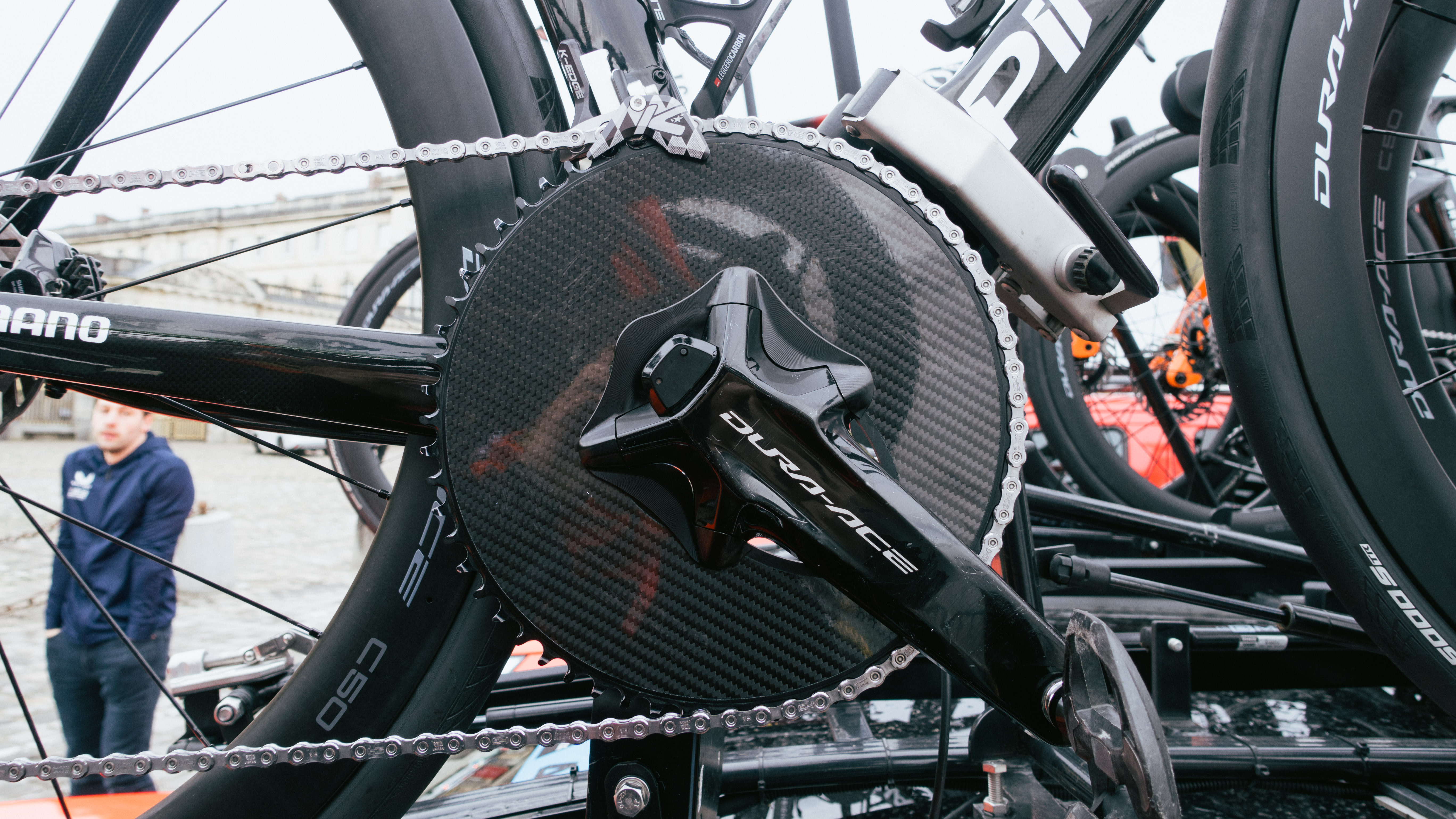

In the fullness of time, and once the mental dust has settled as much as the actual dust has, we will bring you a wash-up of all the key tech trends from the 2024 edition of Paris-Roubaix.
At the time of writing, currently just after the awful cobbles of the Forest of Arenberg and the new chicane entry, it's already been a frenetic race. The race itself, over the years, has been getting steadily faster, thanks in part to tailwinds but also due to the men's peloton almost exclusively opting for aero bikes over anything with concessions to comfort.
This is in pretty stark contrast to what I've shown in the Paris Roubaix women's tech gallery, which had a far greater diversity of bike and equipment options.
This trend towards aero bikes has only been bucked somewhat by Israel-Premier Tech opting to use gravel bikes. Despite the additional tyre clearance, the team went for 32c rubber, and it's a very aero gravel bike, too.
Without further ado, then, I'll take you through the full arsenal of tricks that the teams use to make life a little easier and faster over the roughest parcours on the calendar.
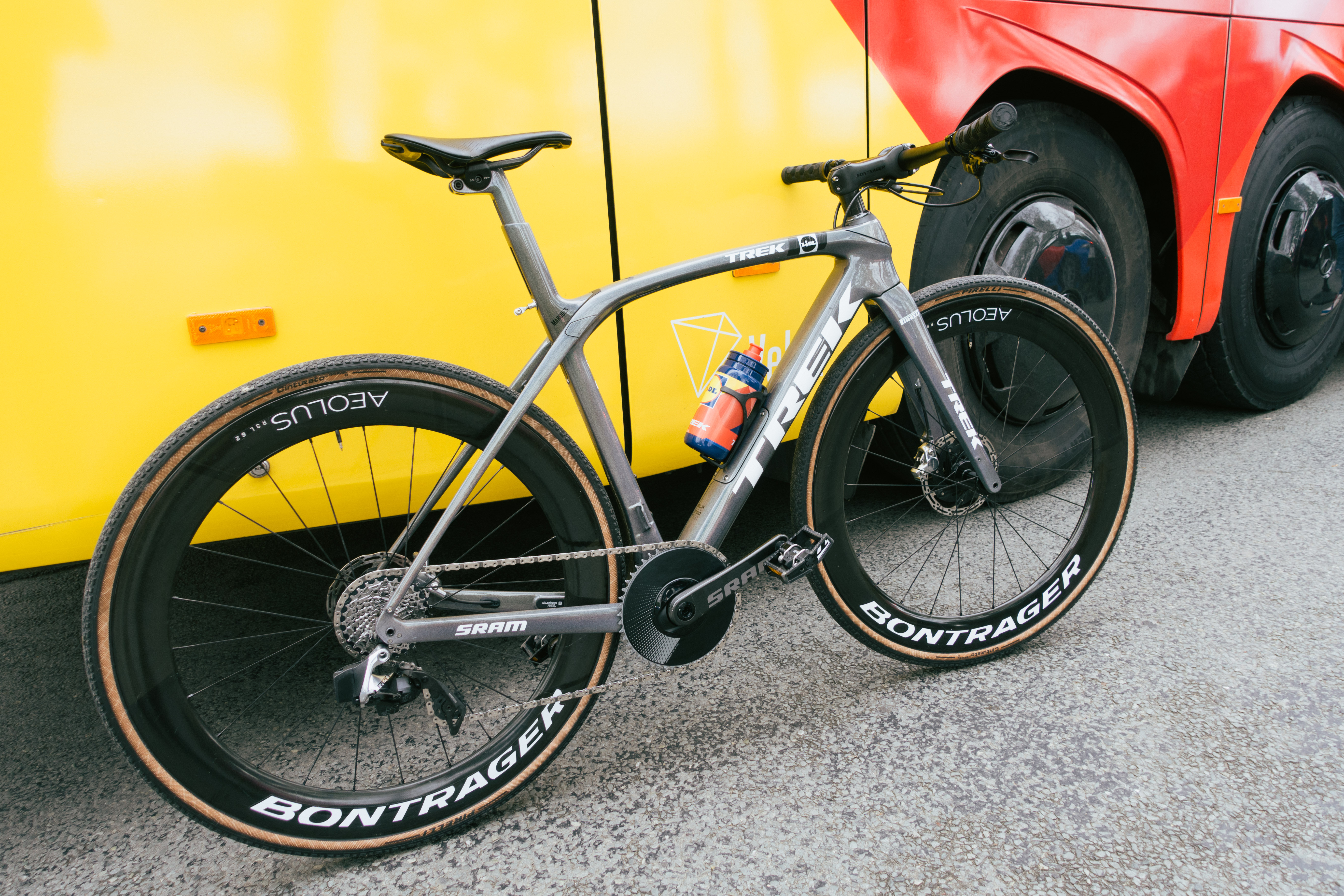
One of the pre race favourites, Mads Pedersen, had perhaps the wildest setup for the cobbles, opting for a flat bar and full on gravel tyres.... Of course, I'm joking; this is the Lidl-Trek bus driver's bike. Cool, but perhaps not quite setup for hitting the cobbles at 65kmh.
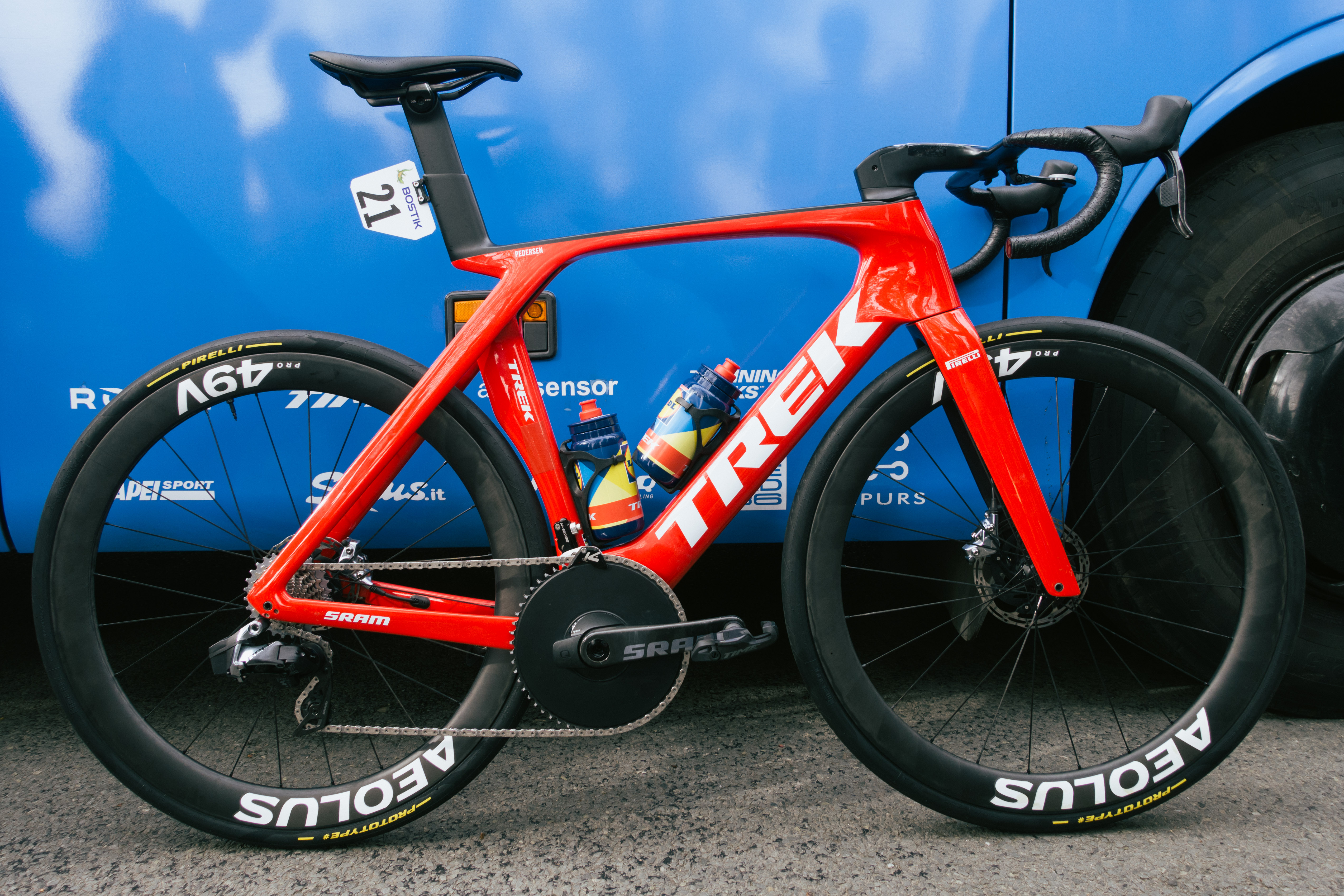
This, however, is Mads' bike. As expected he's using a Trek Madone, complete with a 56t 1x chainring, gravel wheels, and prototype Pirelli tyres.
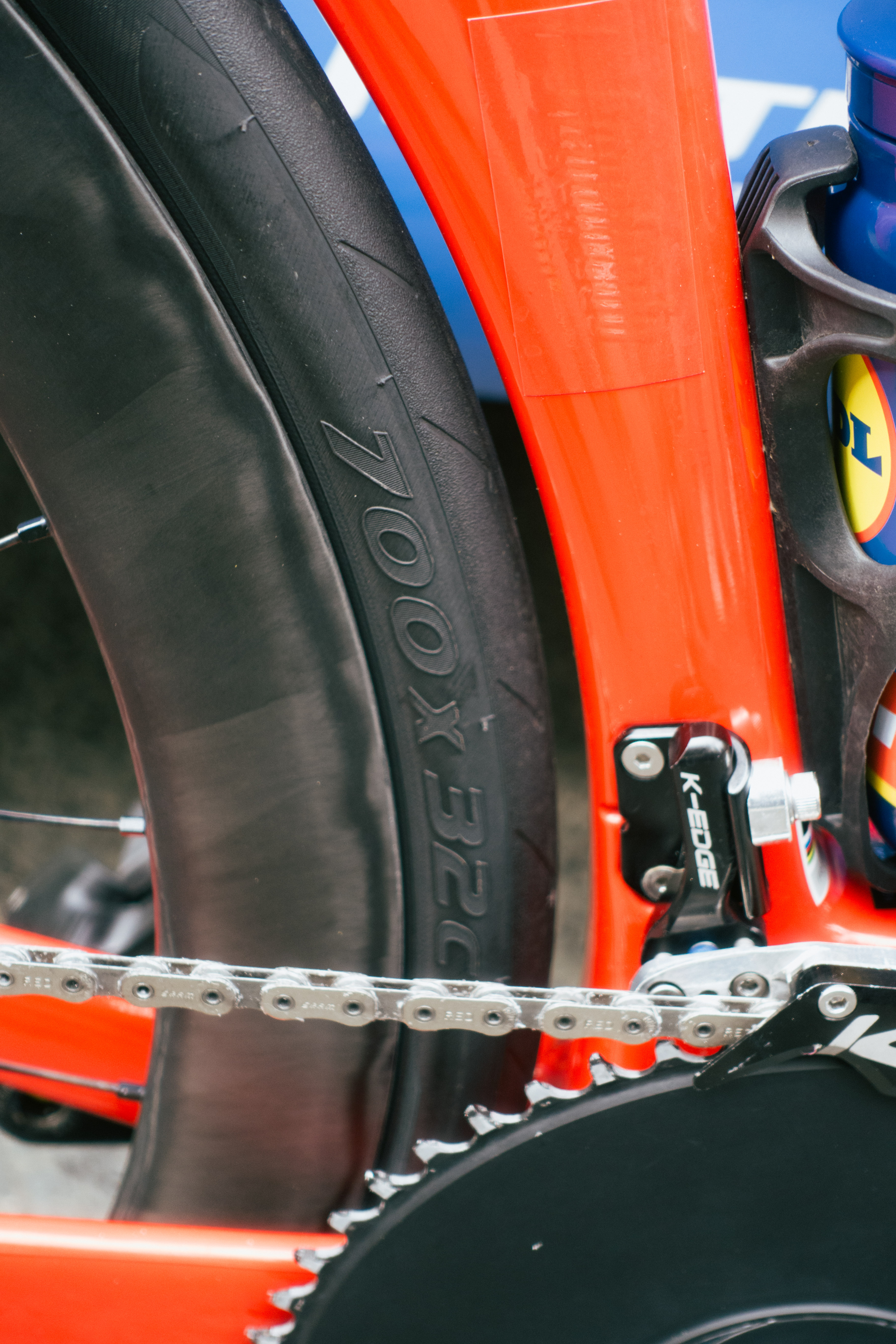
The tyres are marked as 32c, but mounted to the Bontrager Aeolus Pro 49v gravel wheels they measure 34.5mm wide.
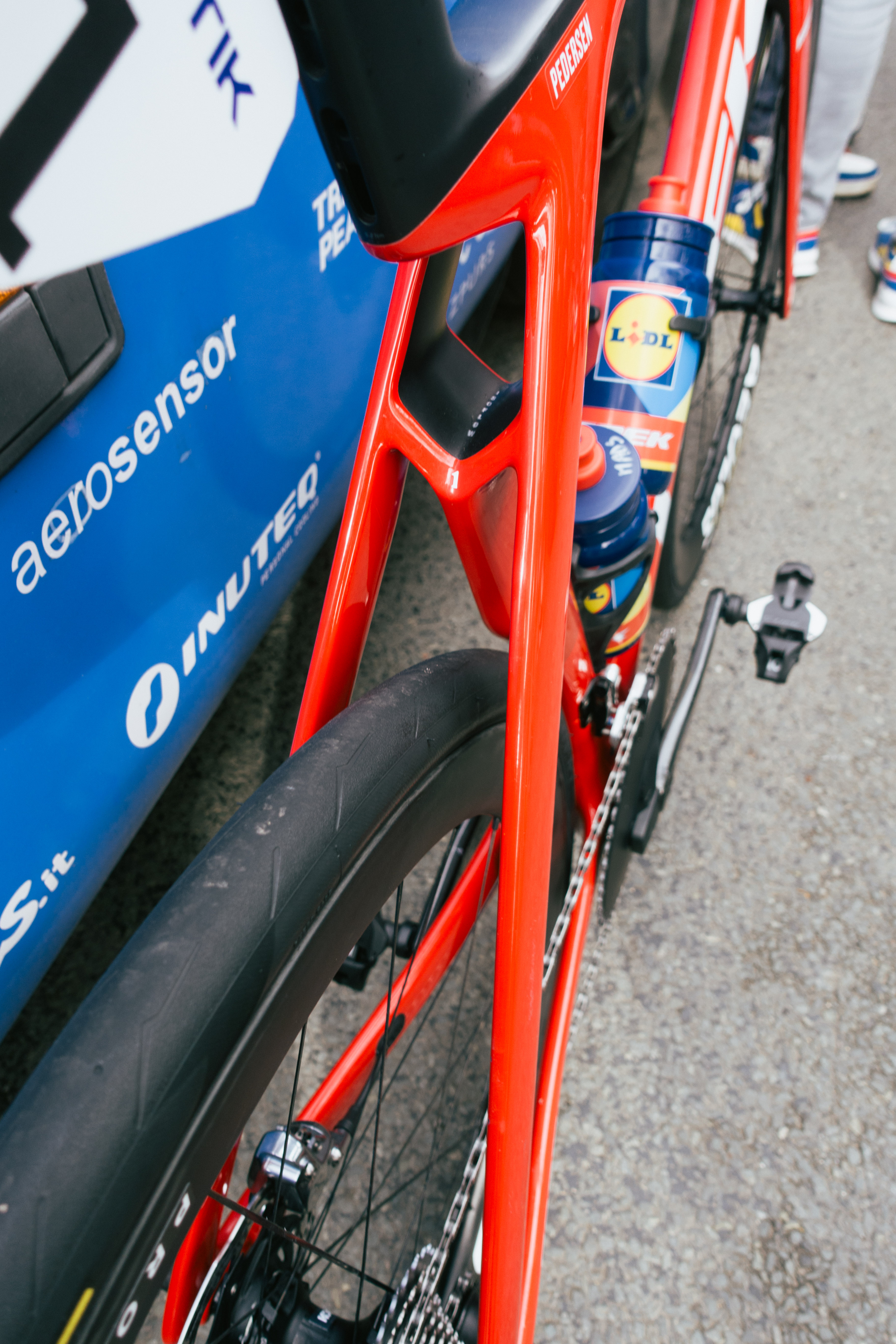
The rear end of the Madone, with its distinctive IsoFlow cutout in the seat tube, can accommodate larger though.
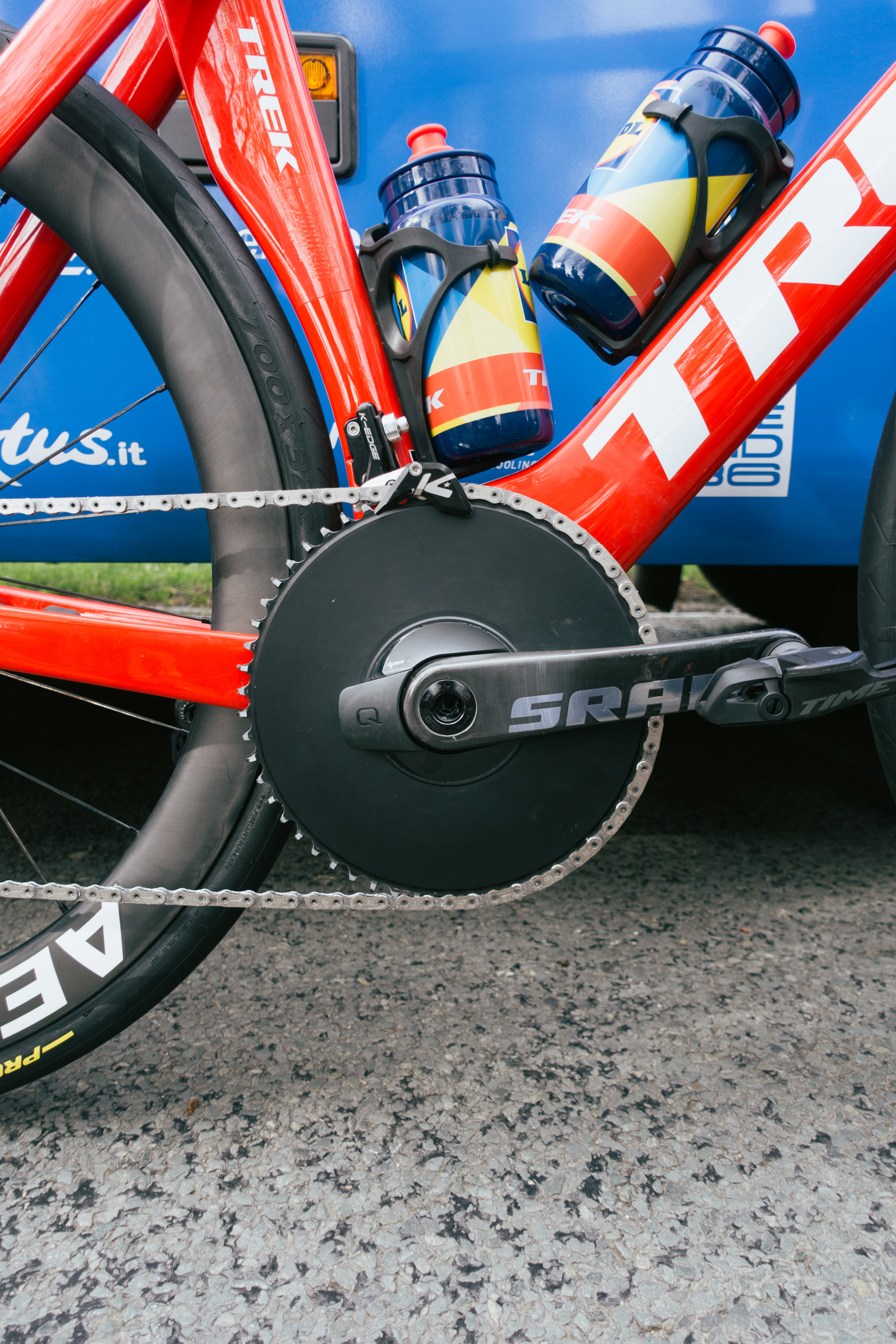
A metal Wolf Tooth chain keeper keeps things secure over the bumps. Mads' bottles are given a bit of extra security by the judicious application of rubber bands to the bottle cages too.
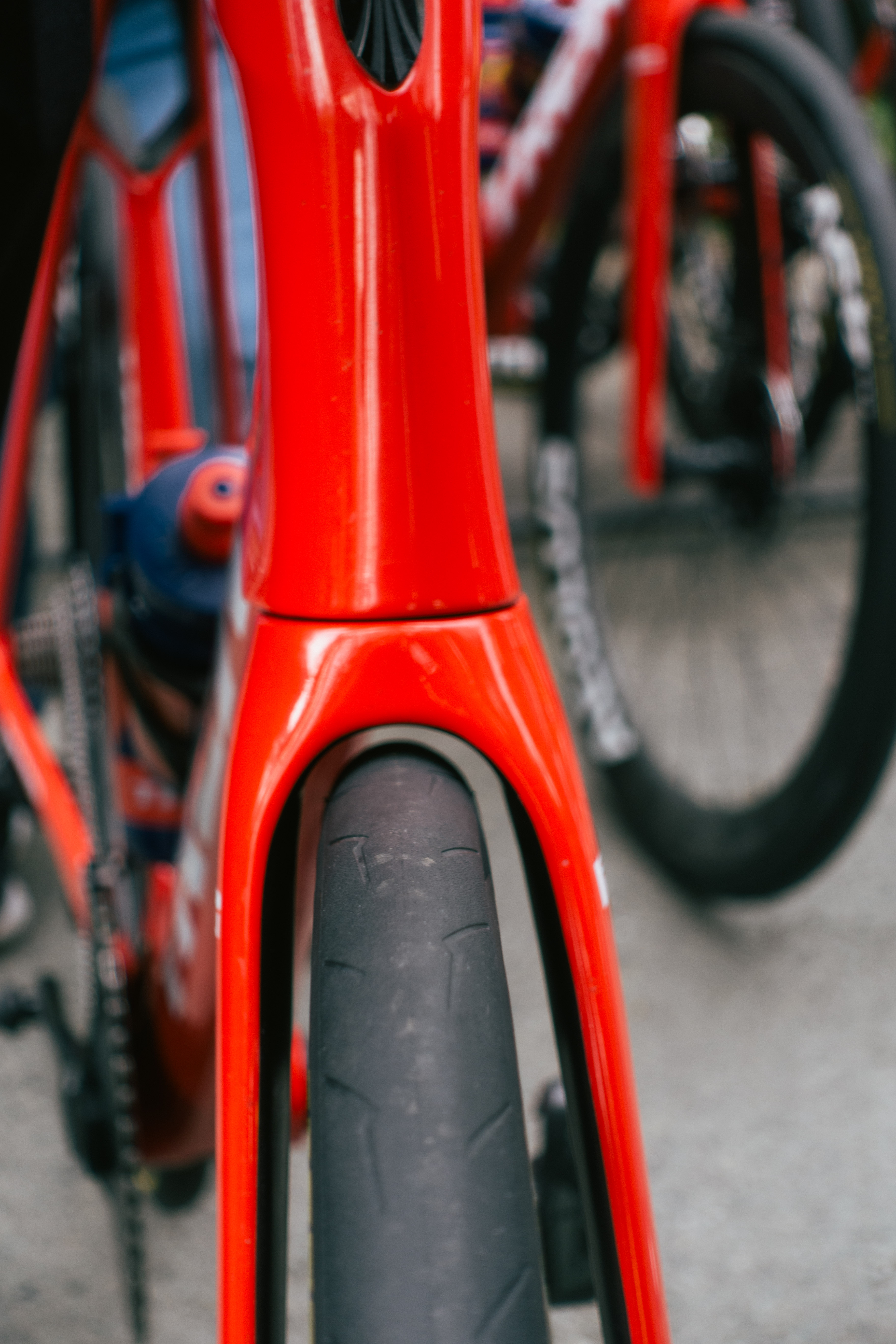
The tyre is a little more snug in the forks, but there's still a good bit of room either side should he wish to use larger tyres in future editions.
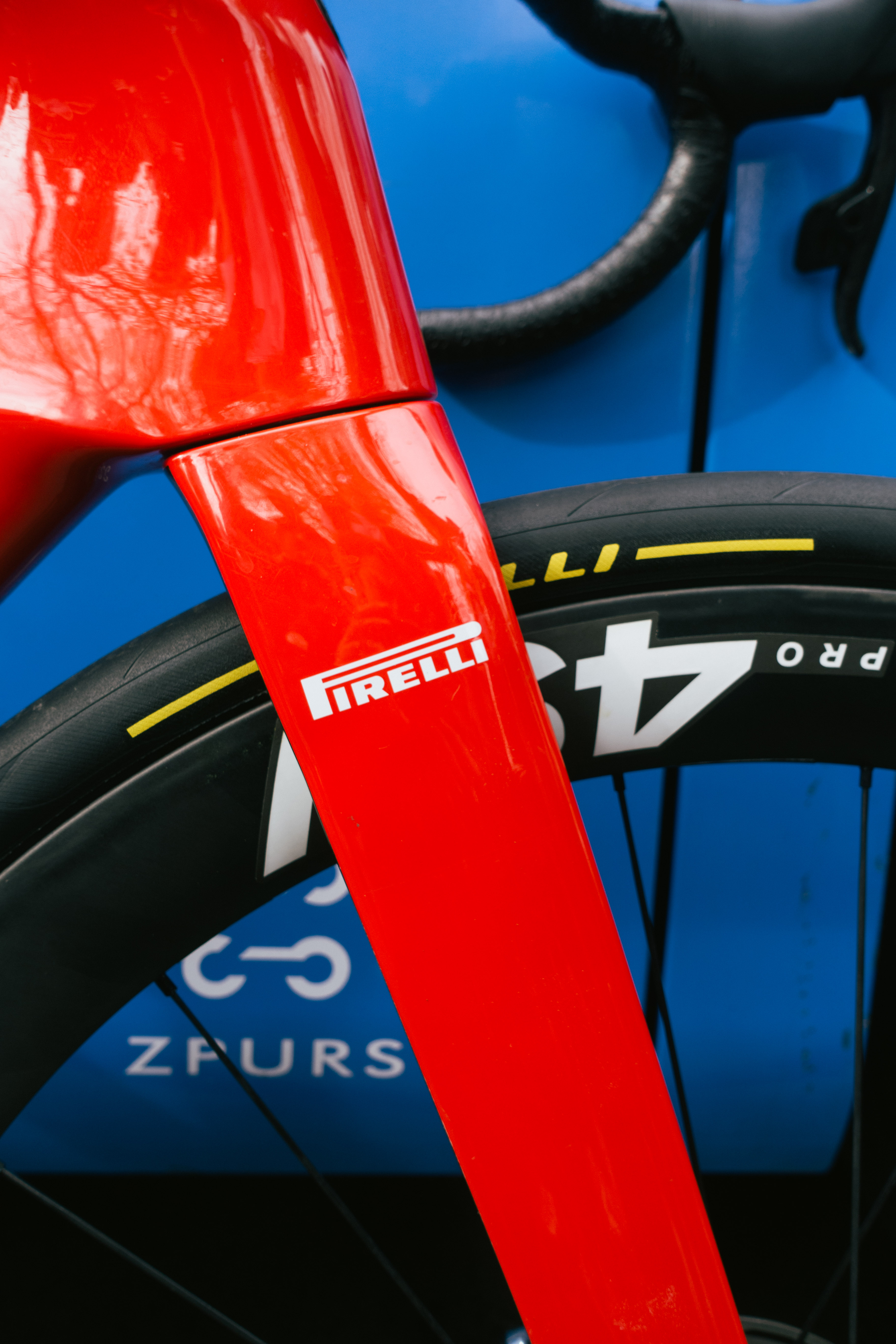
It's a subtle detail, but subtle details are what I live for as a bike nerd... Having the Pirelli sponsor logo exactly lining up with the rim-tyre interface is beautiful.
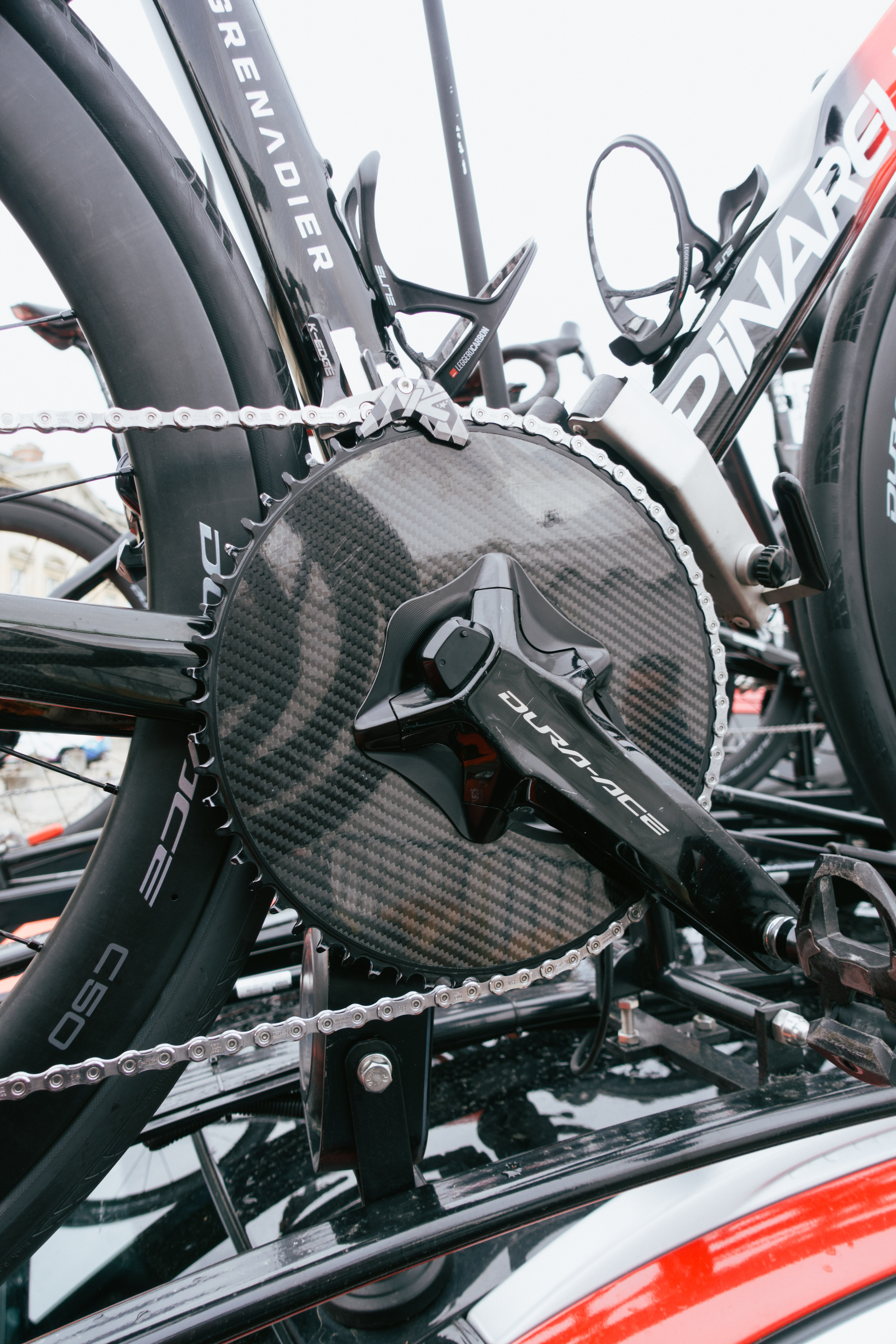
Let's tackle the giant 62t elephant in the room then, shall we? Josh Tarling of Ineos Grenadiers was rocking this monster carbon single ring, though thanks to a bike change following an incident early in the race he had to swap to his spare bike, which was 'only' setup with a 60t 2x setup. It was all for nought though, as the Welshman was unceremoniously ejected from the race after the commissaires deemed one of his bottles was far too sticky.
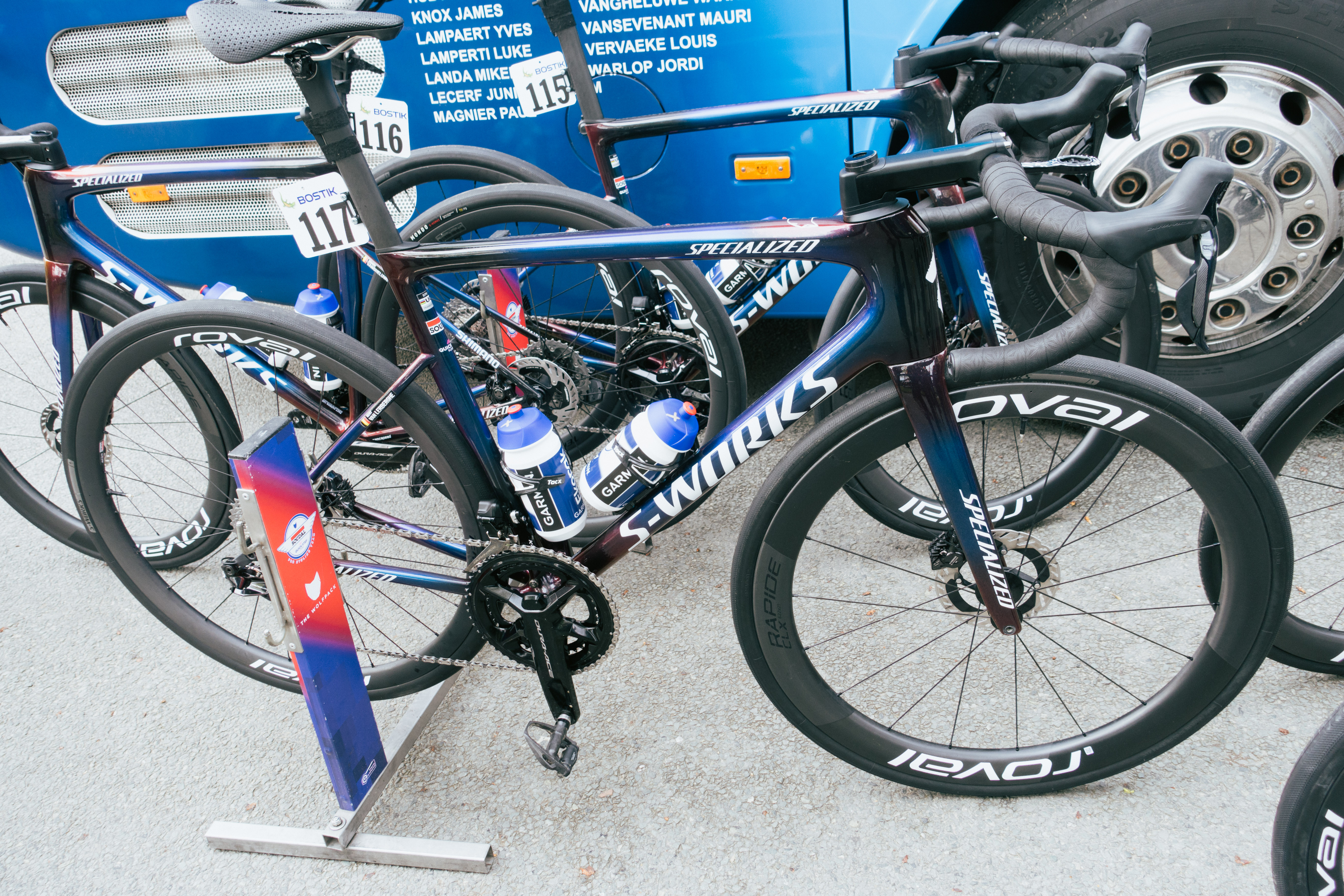
The Roubaix is dead, and the Tarmac is the bike of choice for all Specialized sponsored teams as we predicted. Round bars instead of the aero cockpit isn't the most interesting thing about this (and most of the other) Soudal-QuickStep bikes. No, it's not the tool taped under the saddle either...
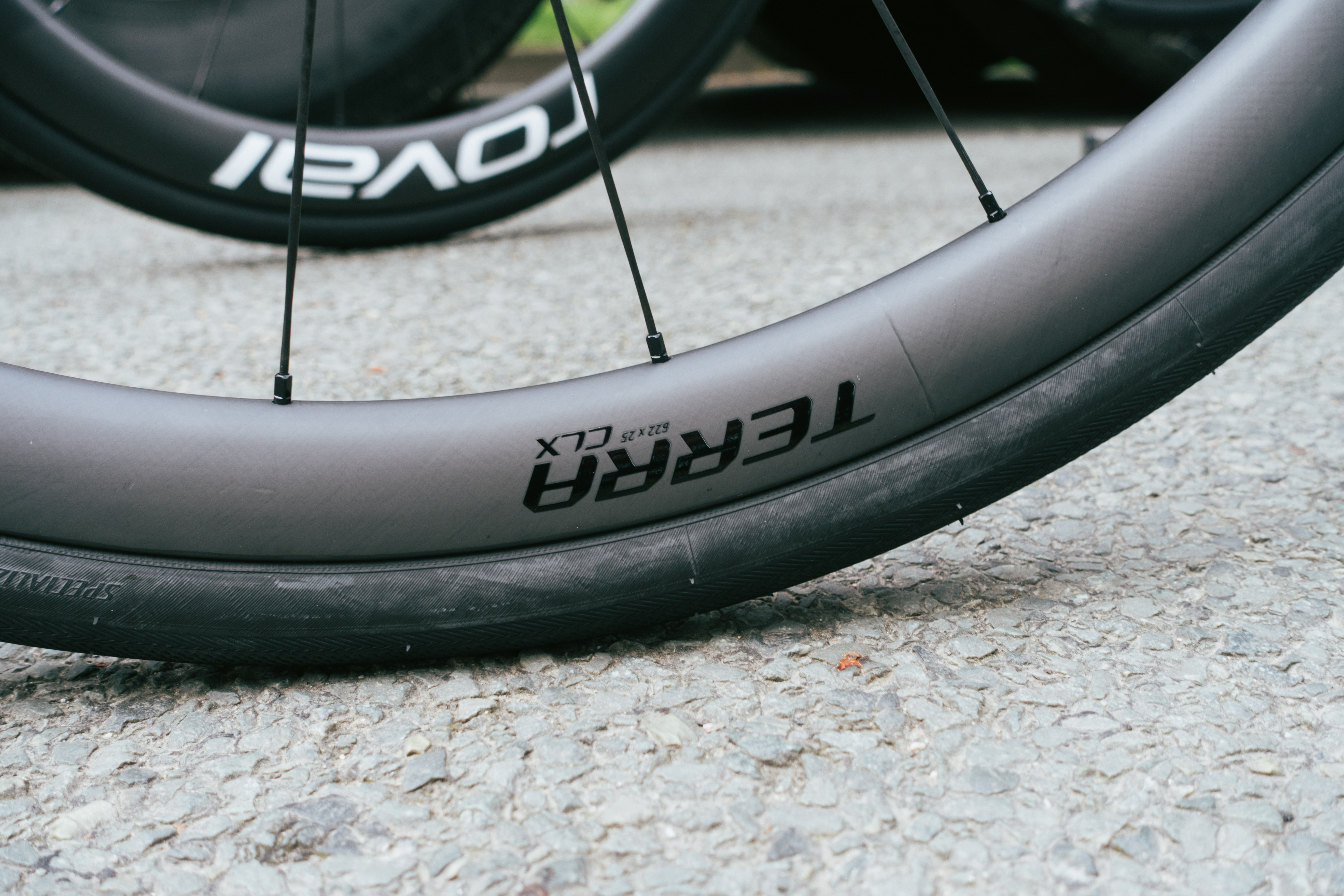
Yes, if you spotted it well done: The team are using a mix of road and gravel wheels. Some riders had a pair of Roval Rapides, some a pair of Roval Terra gravel wheels, but most had a mix, with a Rapide front and a Terra rear.
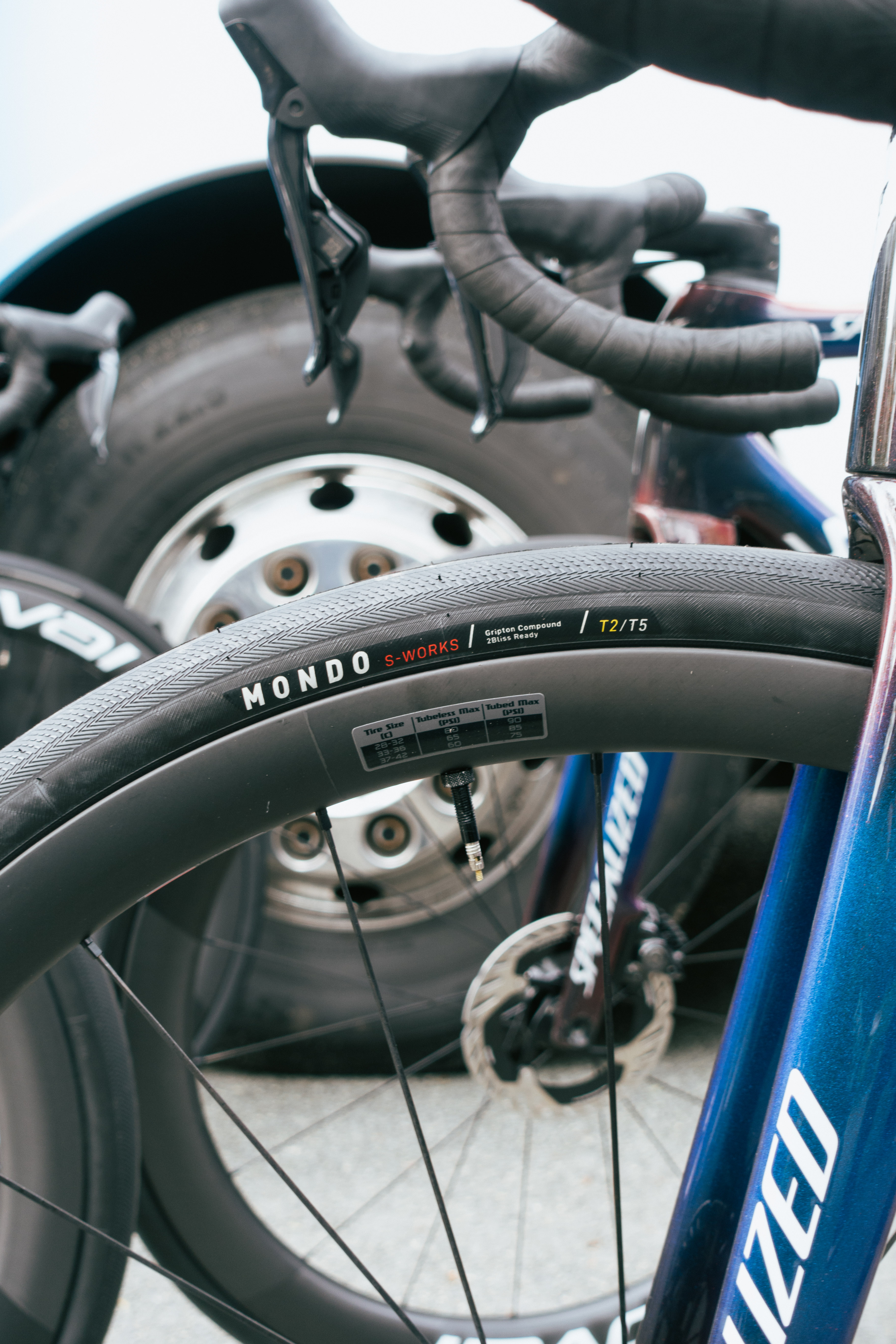
This wheel setup, with an aero front and shallower rear, apparently saved 4 watts over a pair of Terra wheels, with the added benefit of offering up better pinch flat protection at the front due to thicker tyre bed sidewalls. In the comparatively turbulent air at the rear aero makes less of a difference. Whatever rims they were using though, the riders were all on 32c S-Works Mondo tyres, as we suspected.
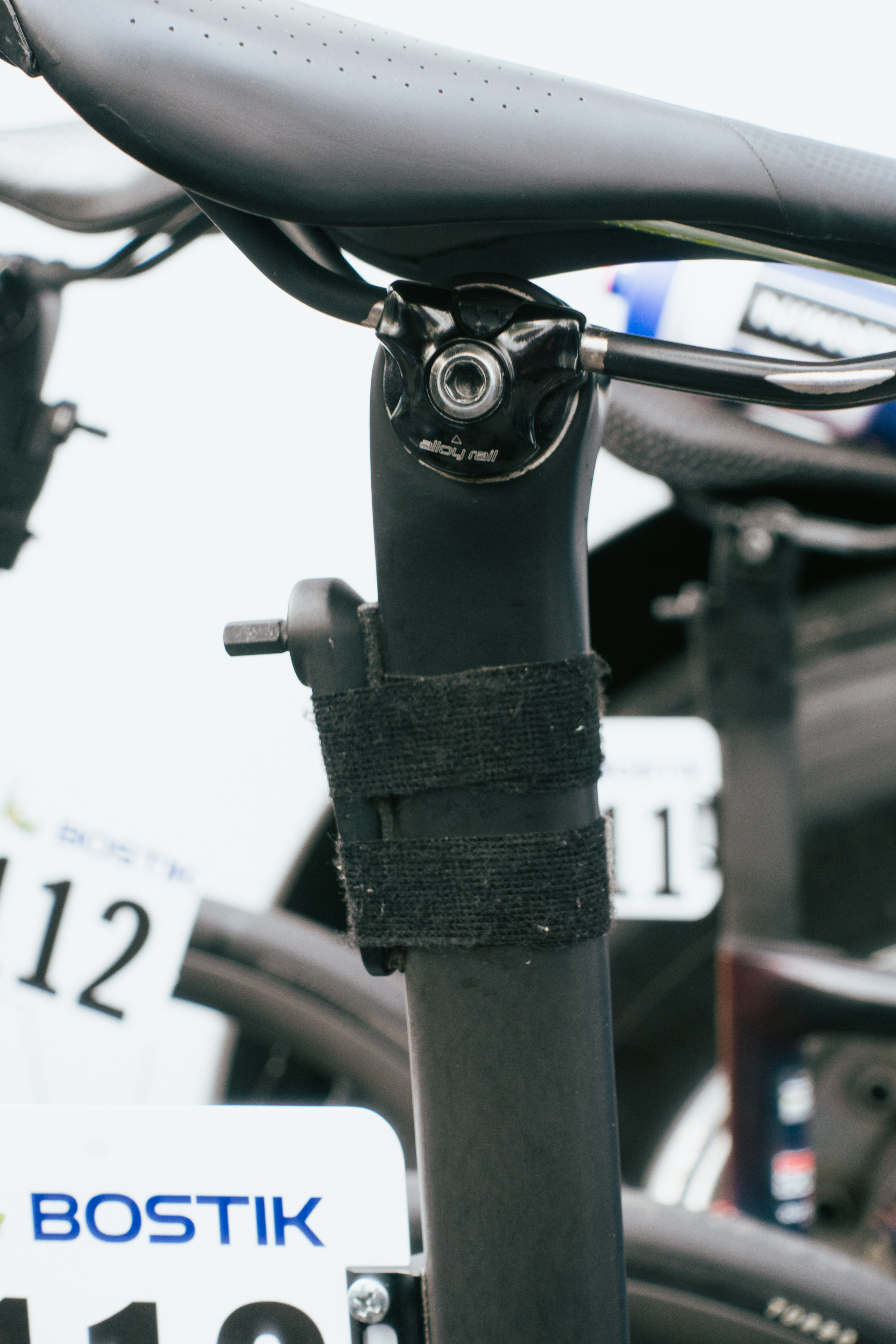
Instead of having the thru axle key in the clean air on the fork legs, the team instead opted to tape it to the rear of the seatpost.
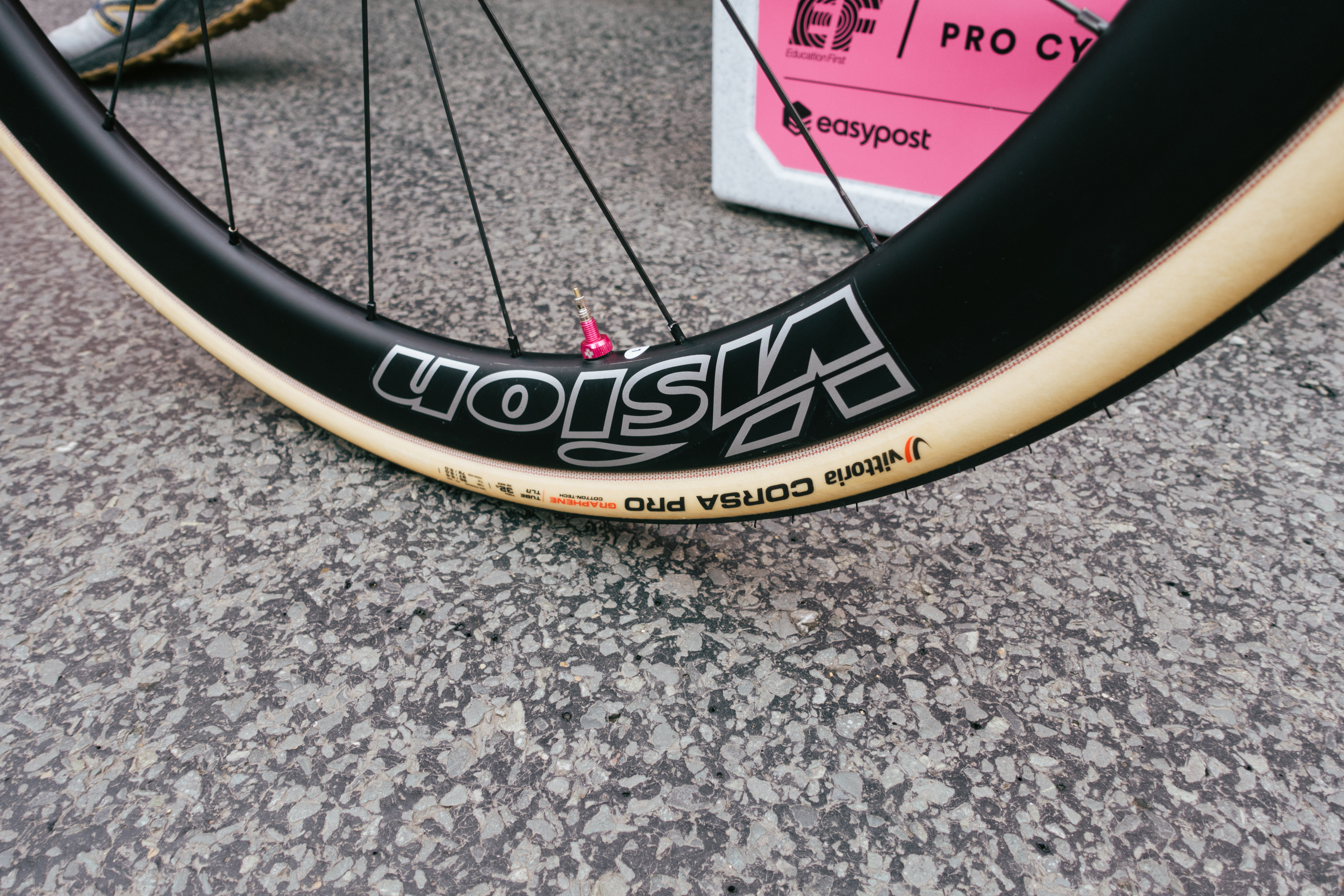
Despite using the more sturdy and more grippy Vittoria Corsa Pro Control at Opening Weekend, EF were using the standard Corsa Pro tyres for Roubaix.
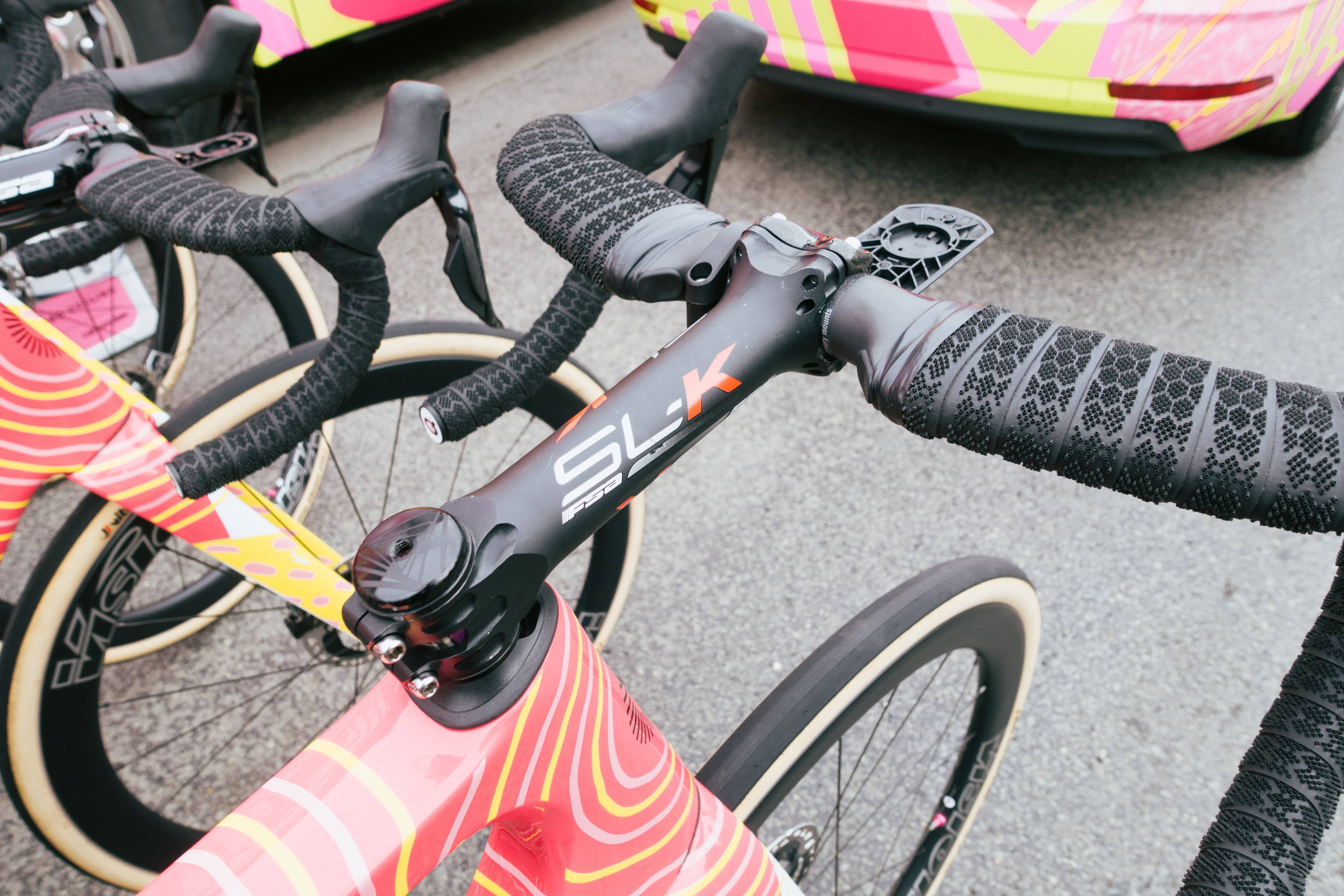
Jonas Rutsch was up to his usual antics with a massive 170mm stem. Personally, I'd worry about the additional lever length, as the force applied through the steerer is going to be significantly magnified over a 'normal' length stem.
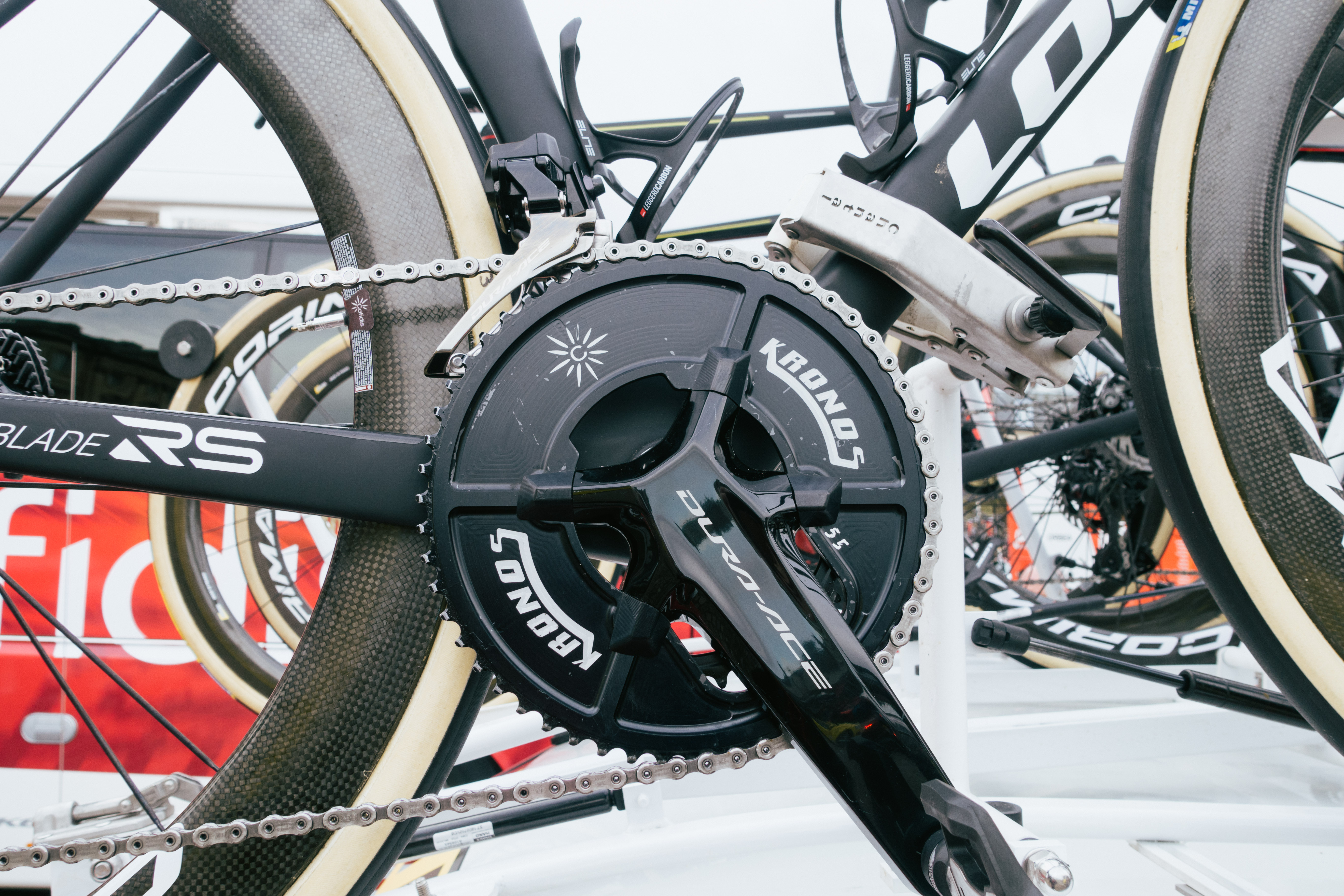
Using non-standard larger chainrings was par for the course more or less across the board. Here Cofidis have opted to use a 55t Kronos front ring, in a 2x setup.
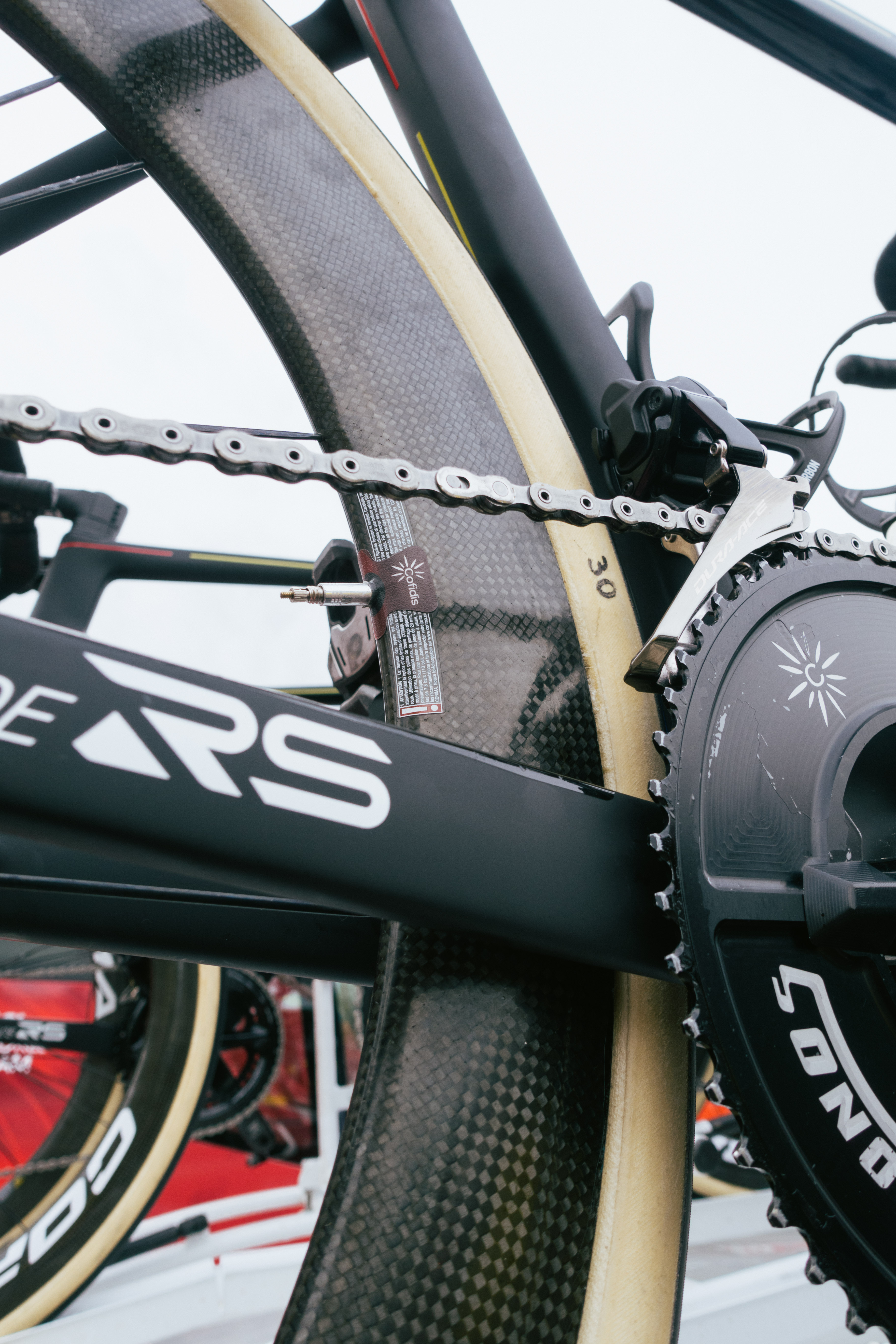
Despite most teams opting for 32c tubeless tyres, Cofidis stuck to their distinctly old school guns and went with 30c tubular tyres glued up to Corima wheels.
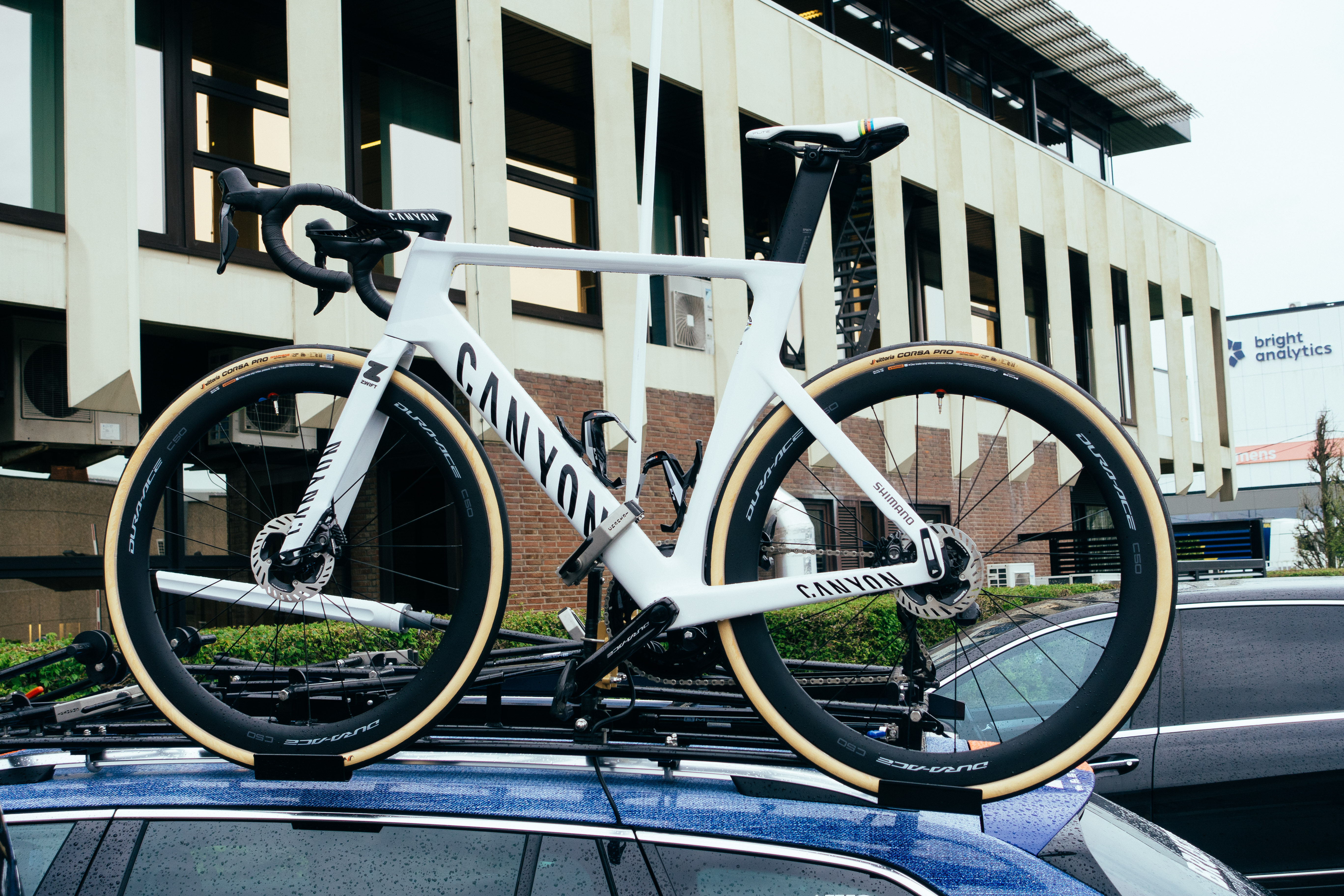
Mathieu van der Poel, the overwhelming favourite, opted for an incredibly standard setup.
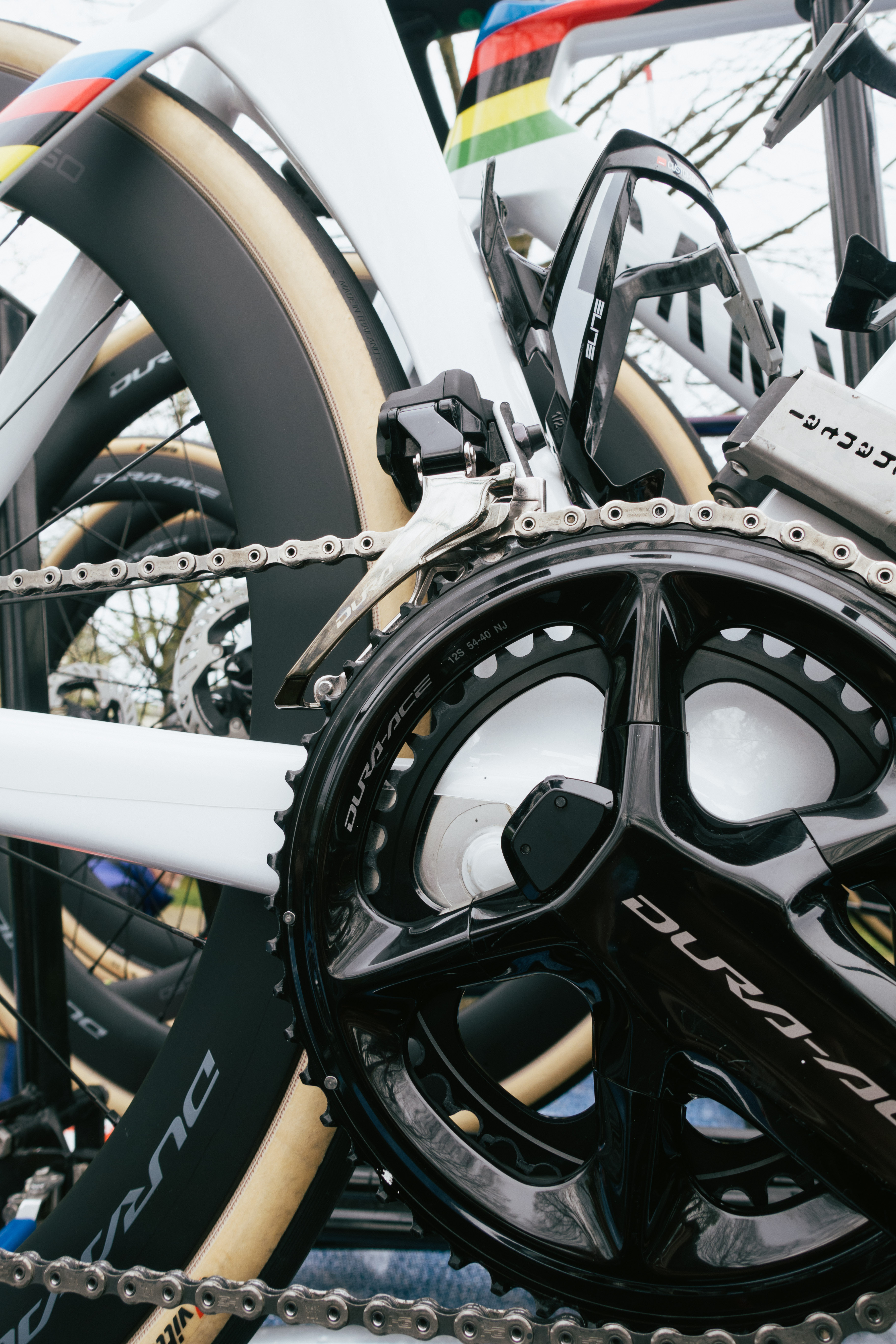
No mega chainrings here, just his normal 54.40 chainset.
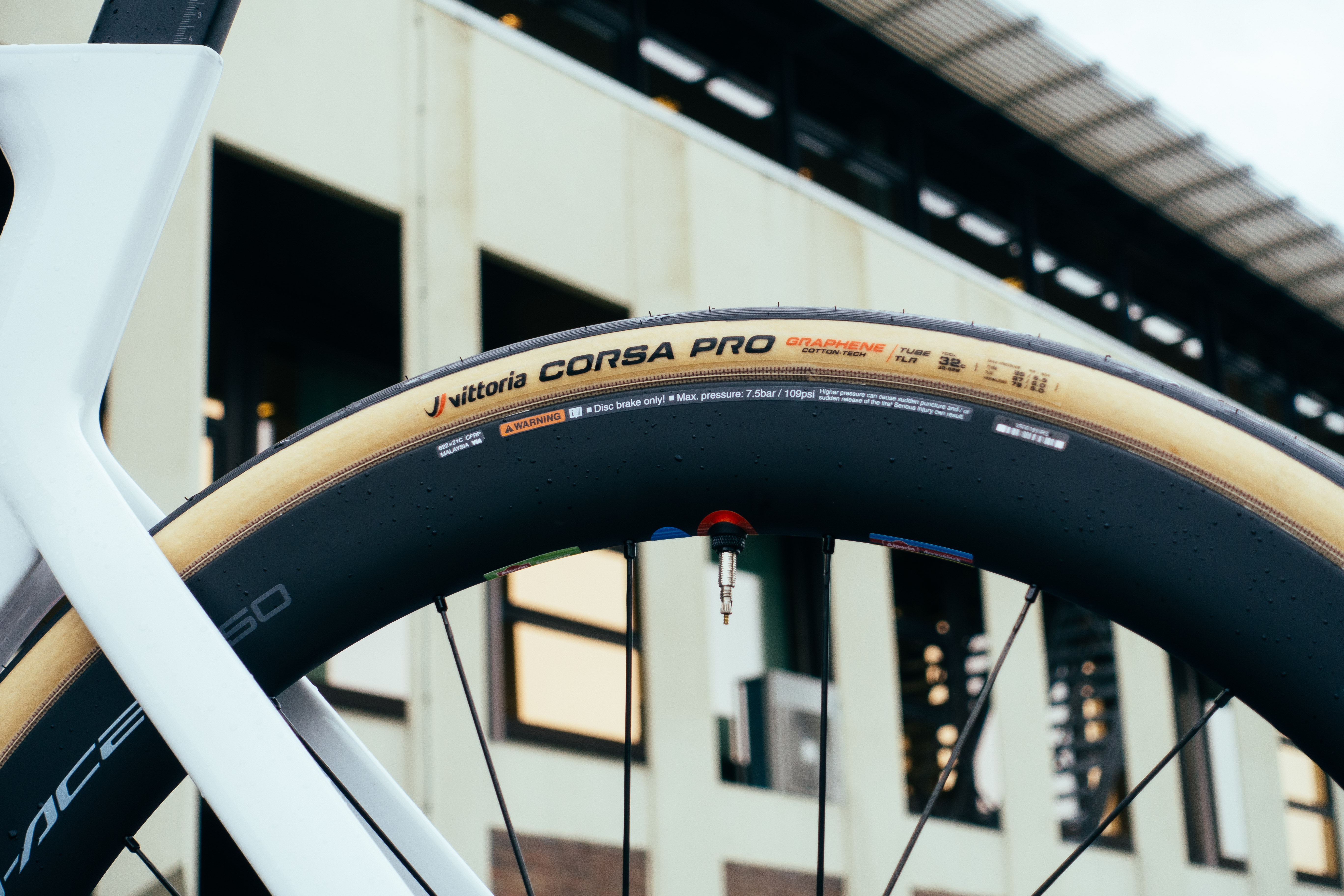
He did use larger than usual 32c Vittoria Corsa Pro tyres, with tyre inserts too, but besides this and double bar tape it was just his normal Canyon Aeroad.
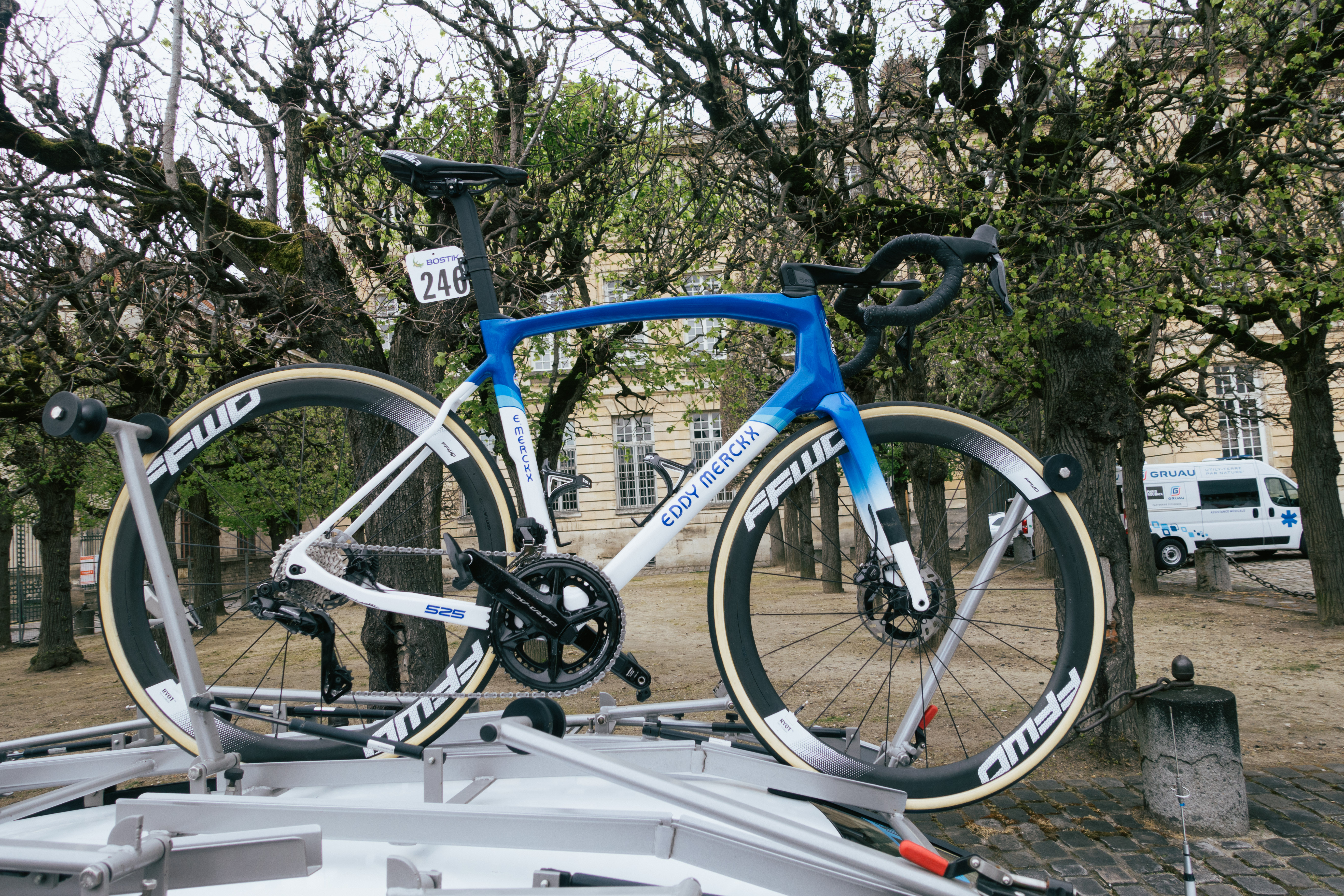
Team Flanders–Baloise use Eddy Merckx bikes, but one rider was lucky enough to use this Panasonic throwback paint edition of the bike. As well as Cofidis, they were also one of the few teams still using tubs.
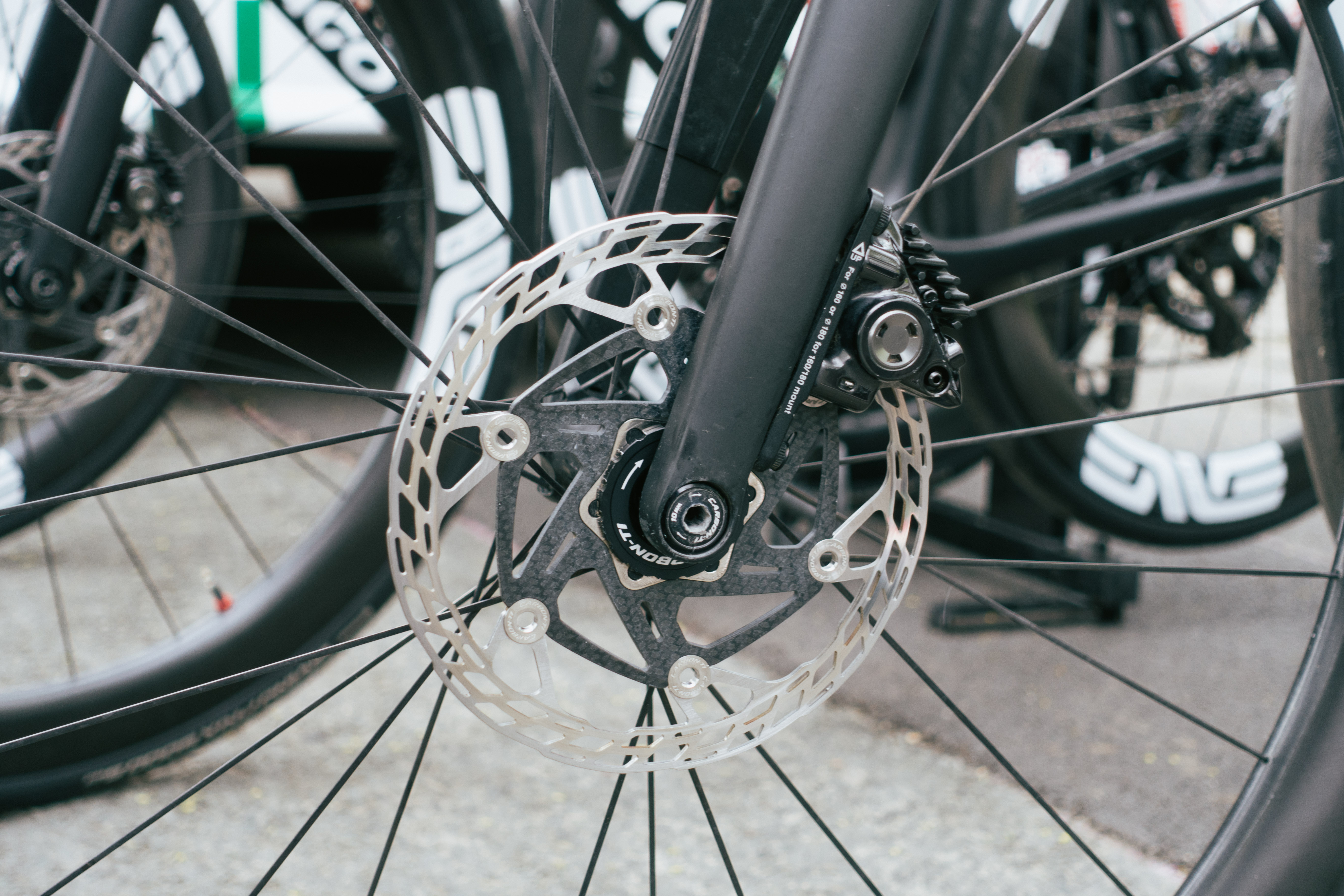
Carbon-Ti brake rotors? It can only be the UAE Team Emirates.
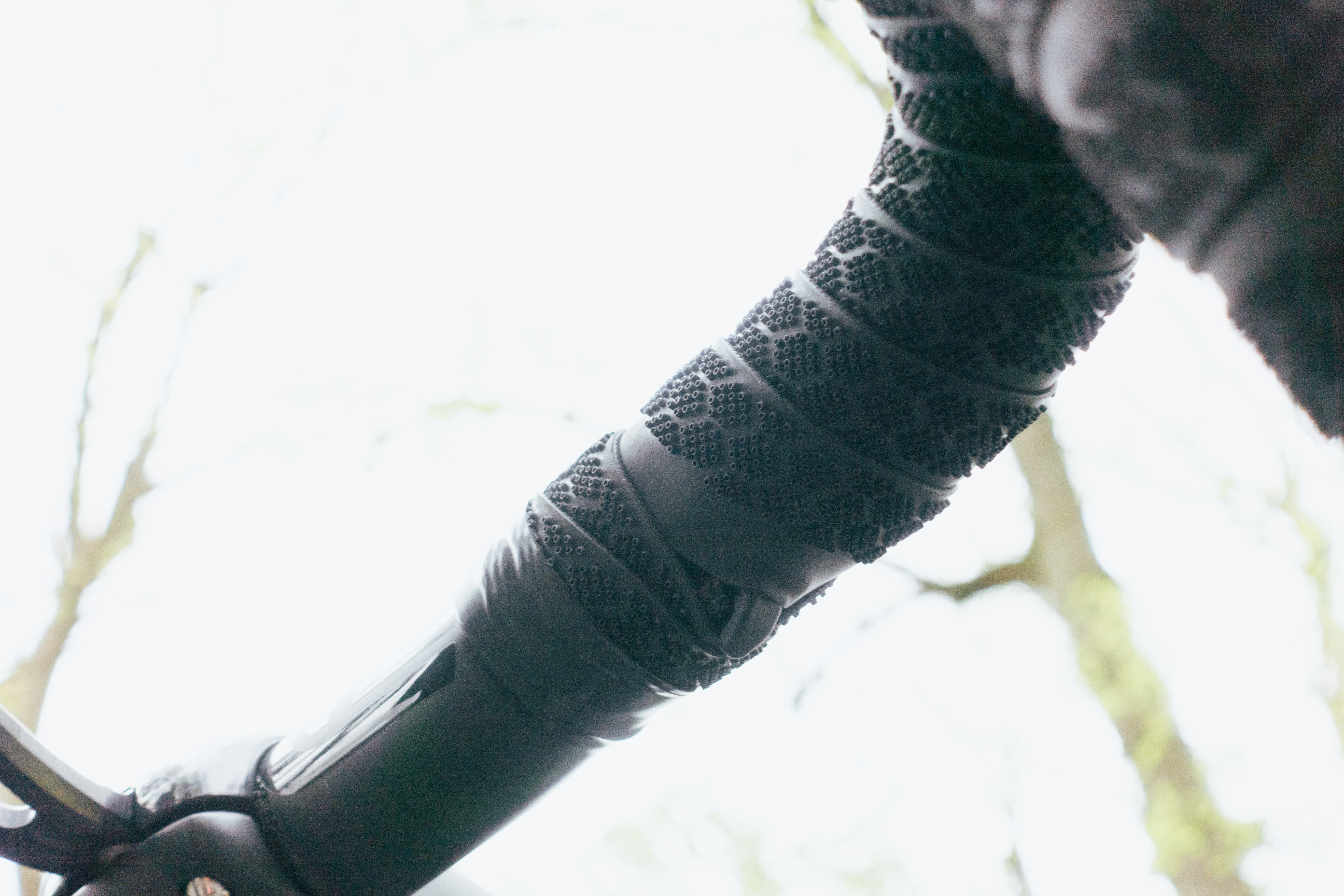
That Prologo bar tape that we saw in the women's peloton has proliferated here too, and covers some satellite Shimano shifters under the tops.
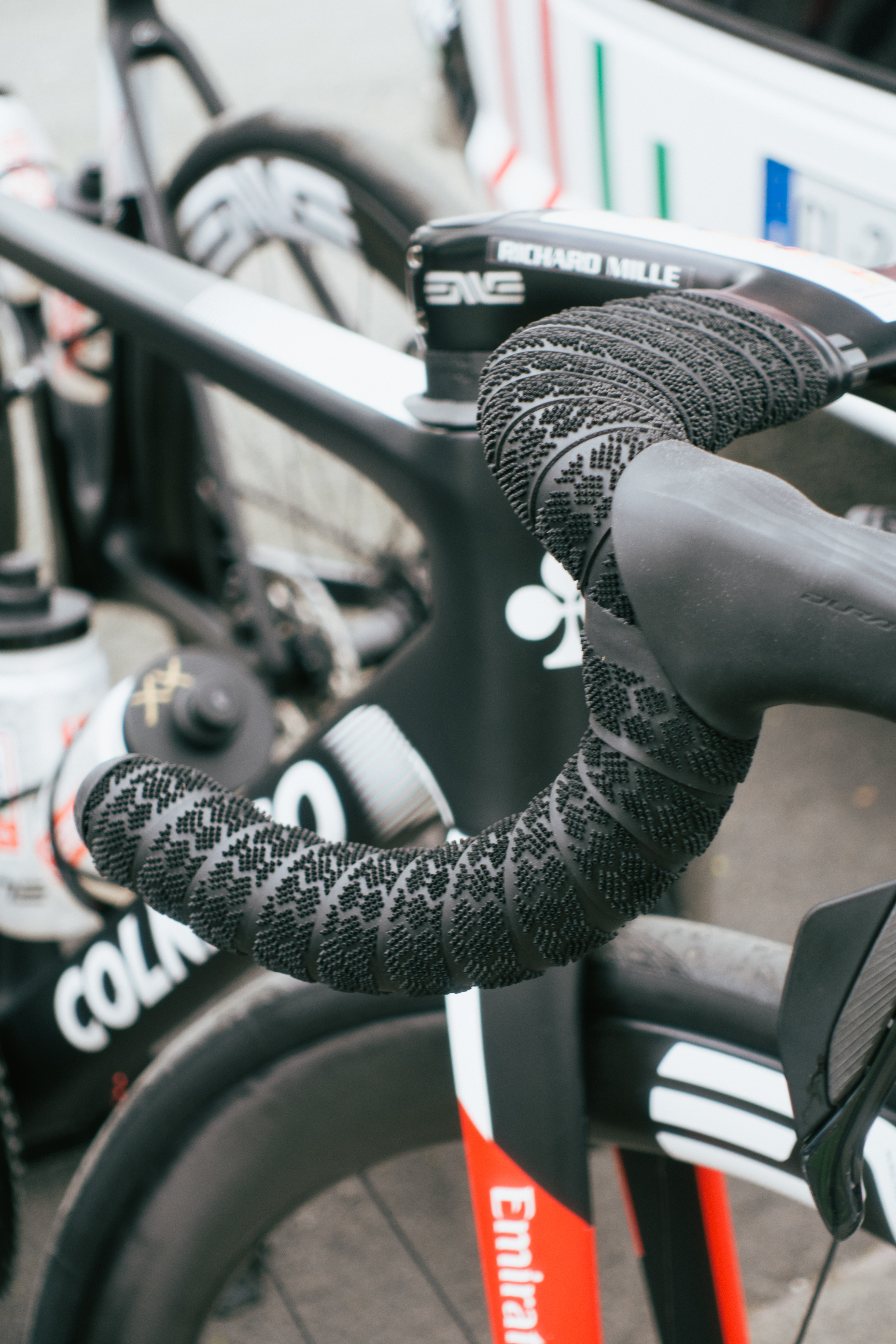
The little bristles are said to offer greater mechanical grip, meaning the riders have to hold the bars less hard and fatigue less.
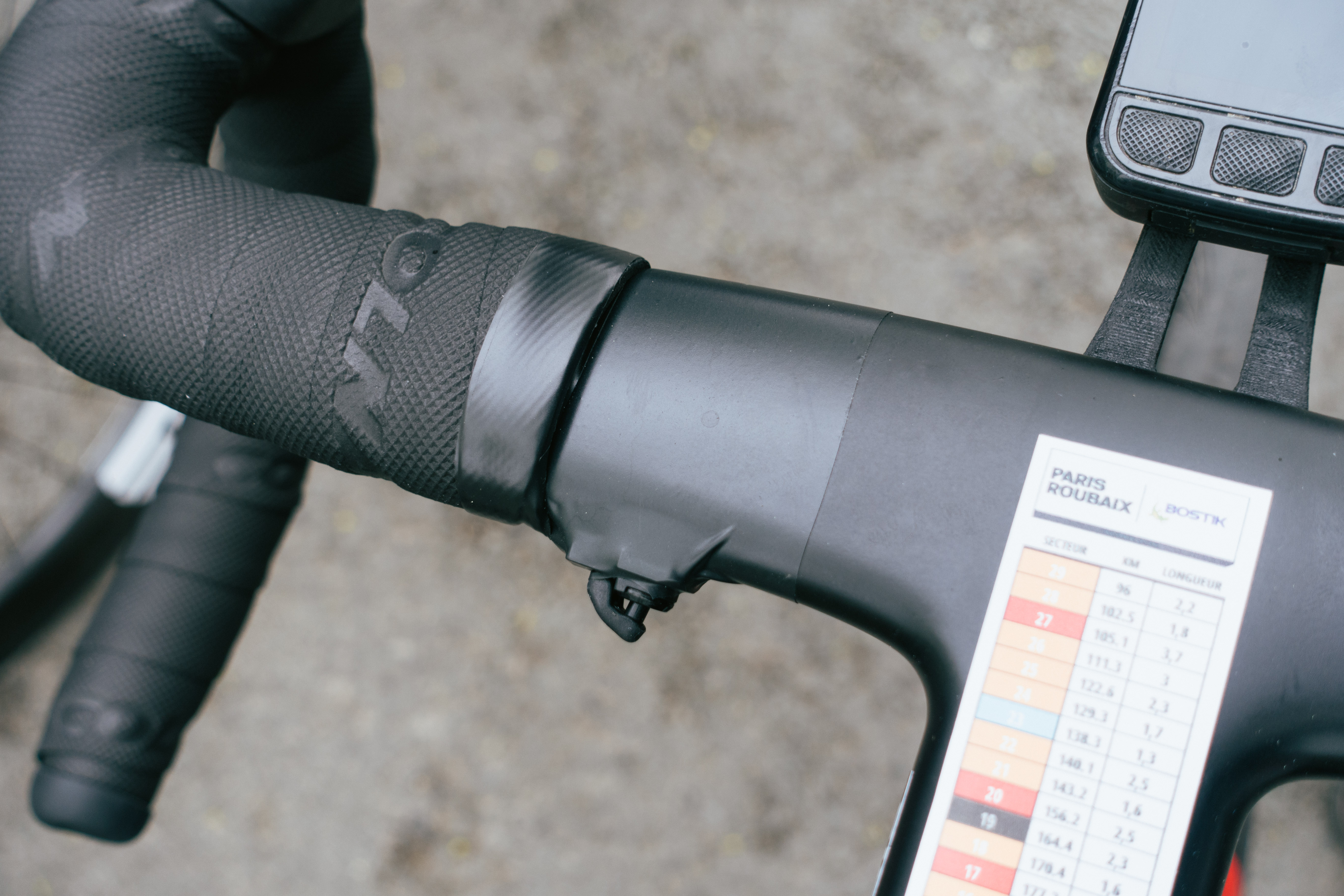
More satellite shifters, here thumb operated, and mounted to the Colnago one-piece cockpit.
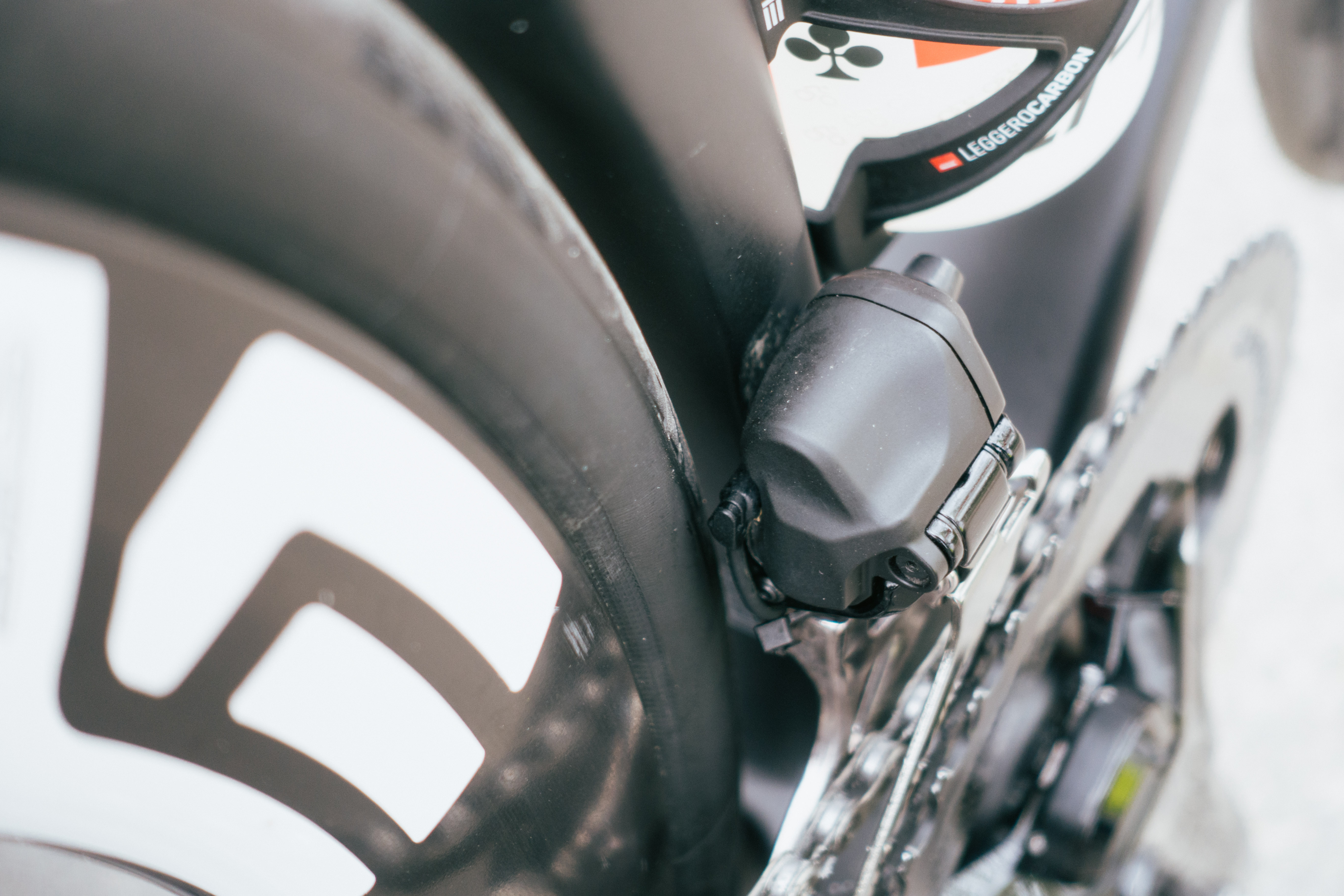
Curiously, the limit of tyre clearance isn't usually determined by the frame or the forks, but by whether the bike is setup 1x or 2x. With a front derailleur, especially a Shimano one, the clearance to tyres can be extremely slim. Here a 32c, plumped by wide rims, barely fits.
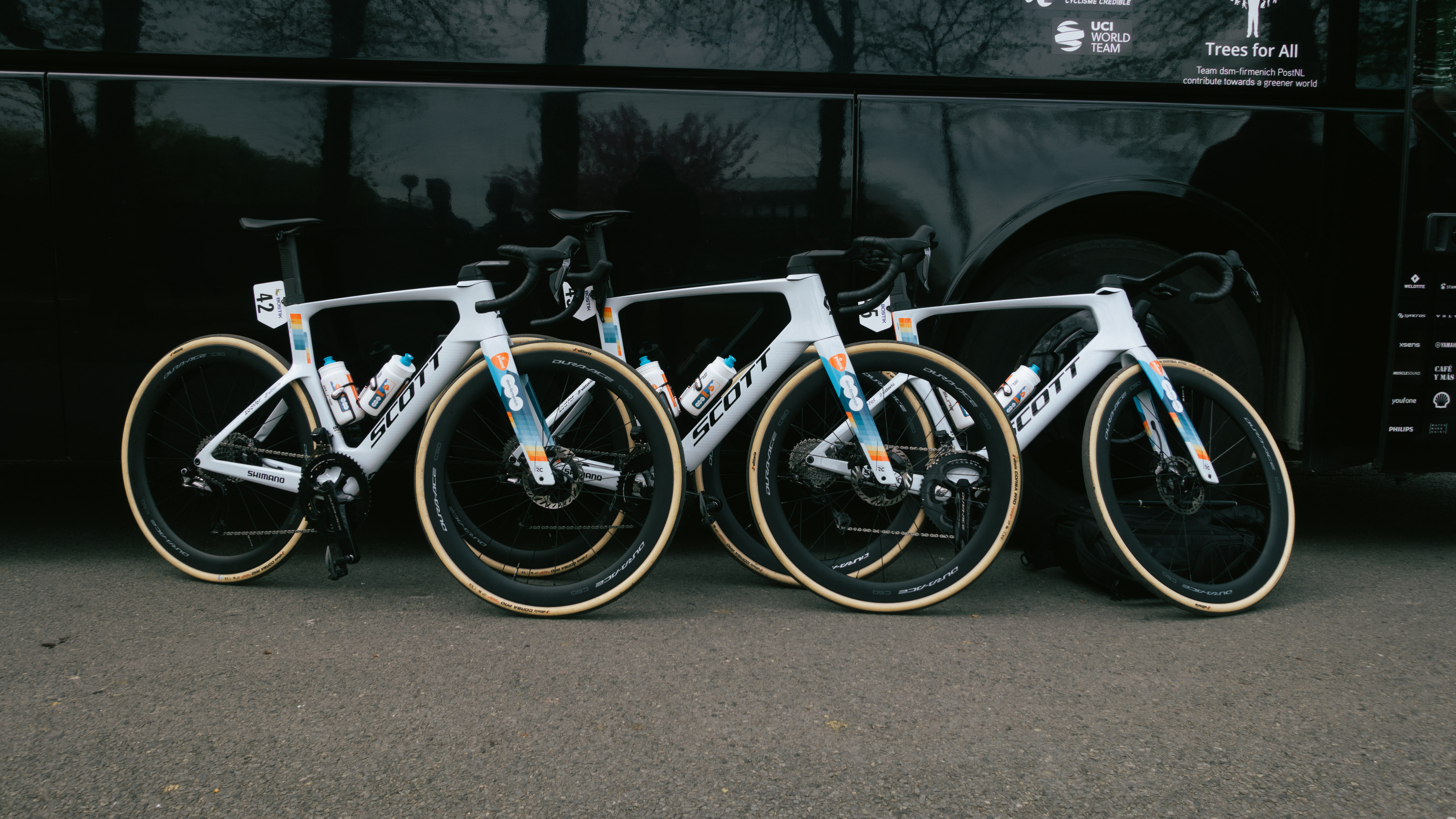
The Scott Foil RC bikes of DSM-Firmenich were more or less standard, save for a couple of cobble mods.
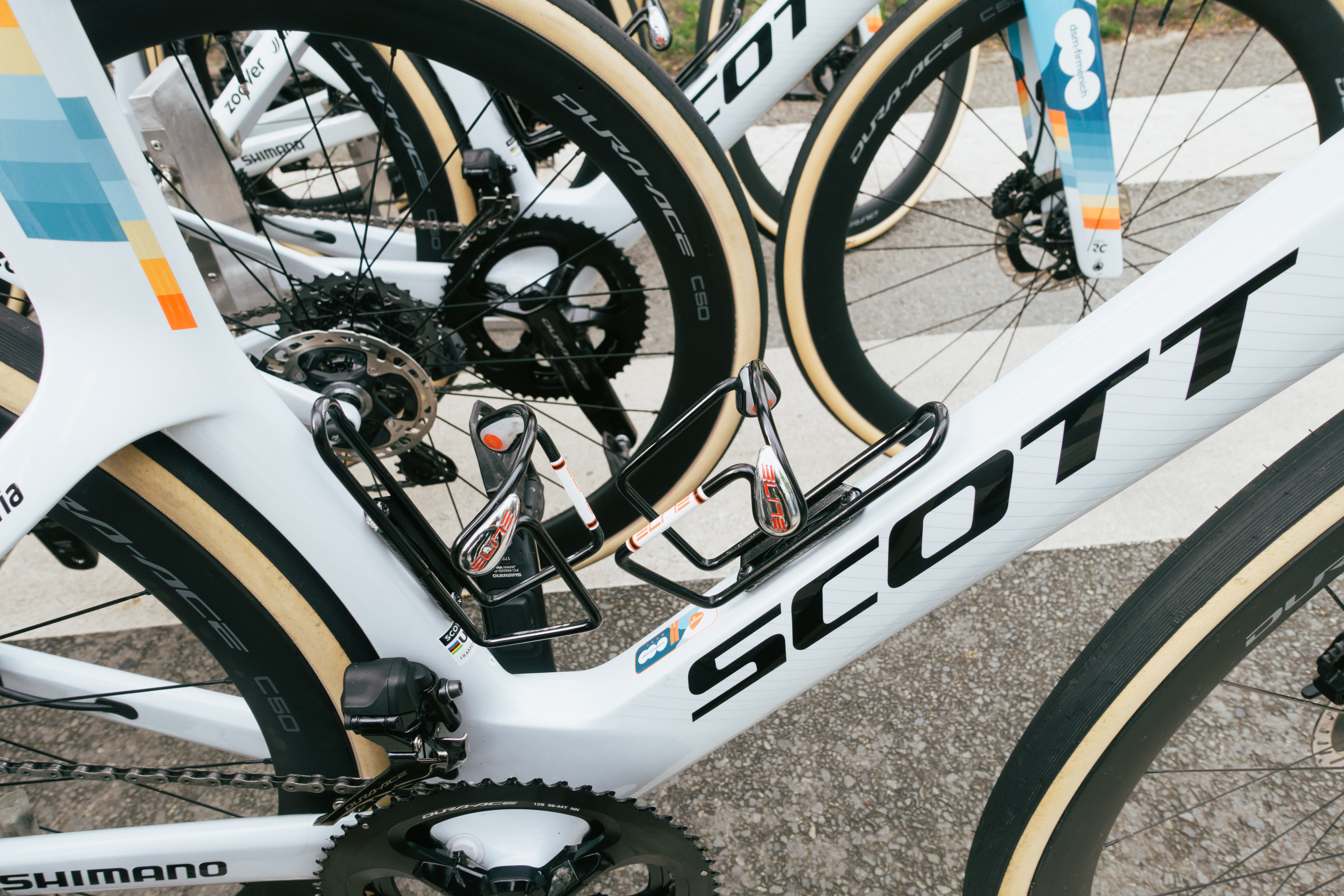
Metal Elite bottle cages, which can be bent in to clamp the bottles harder, are a classic trick.
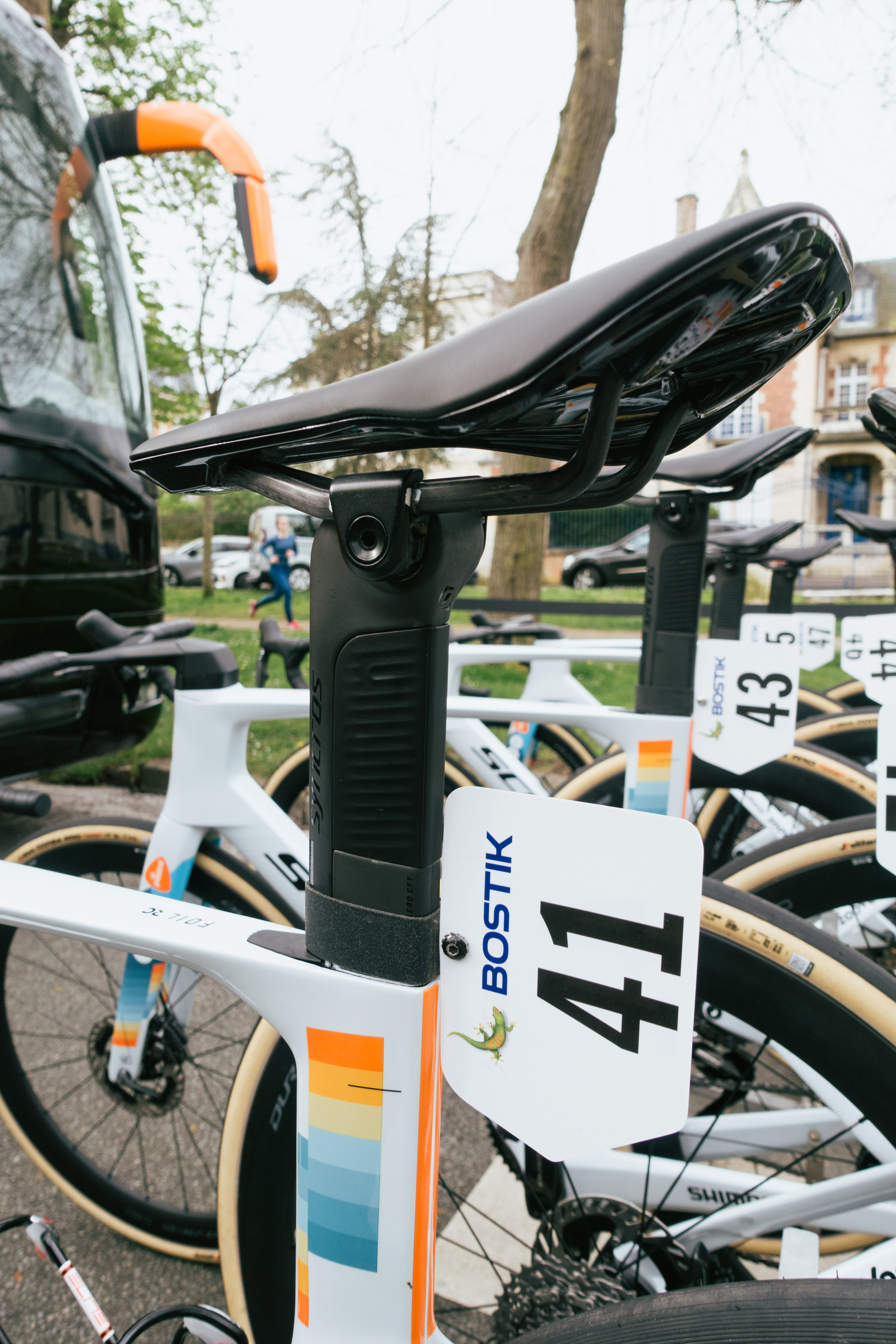
Despite the the bikes' seatposts, which feature an elastomer insert to add a little bit of cushioning, usually being swapped for a solid one, they've brought them back for this weekend.
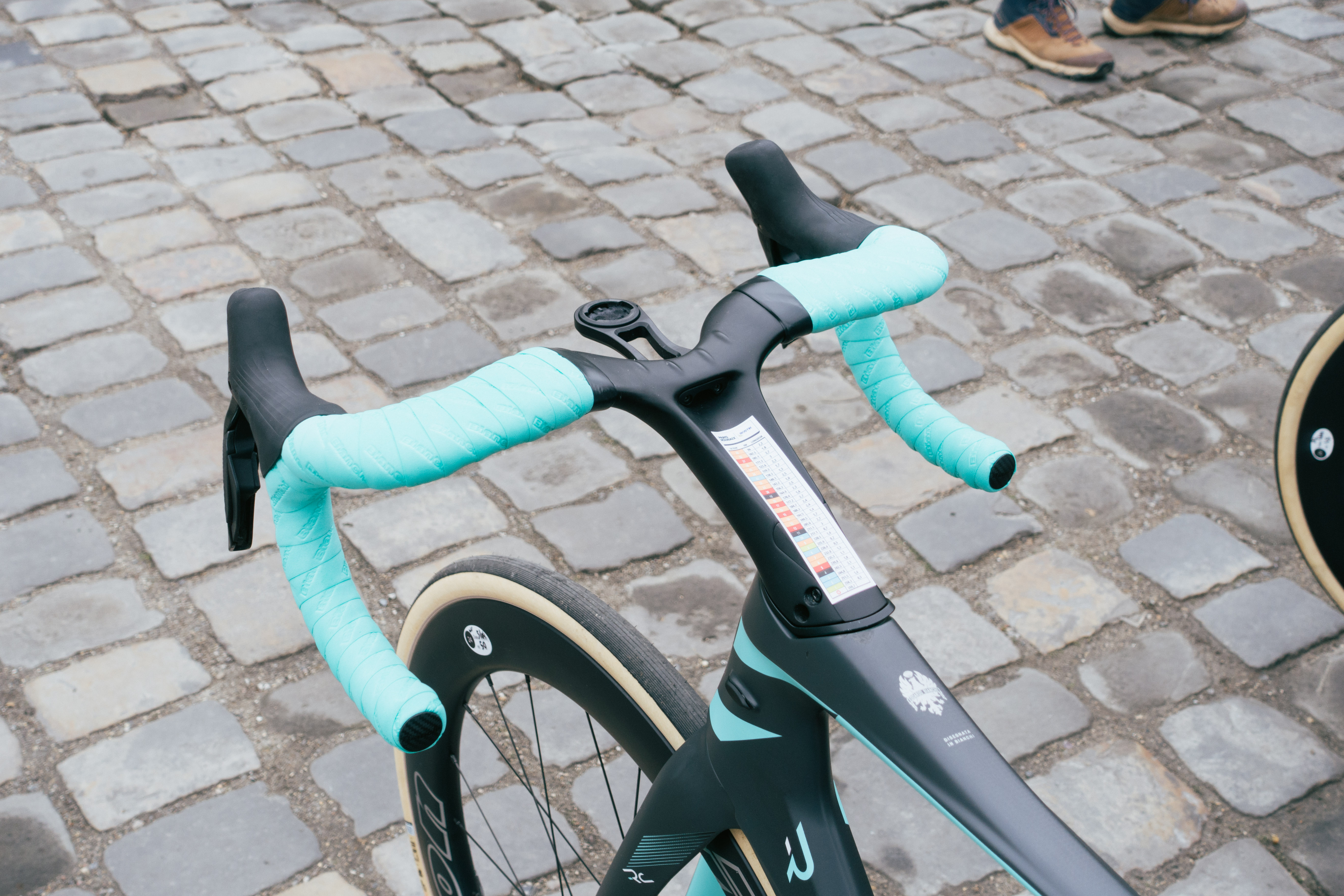
At the Arkea B&B Hotels camp the riders were using a mix of the Bianchi Specialissima and the more aero Oltre, as seen here with its striking cockpit.
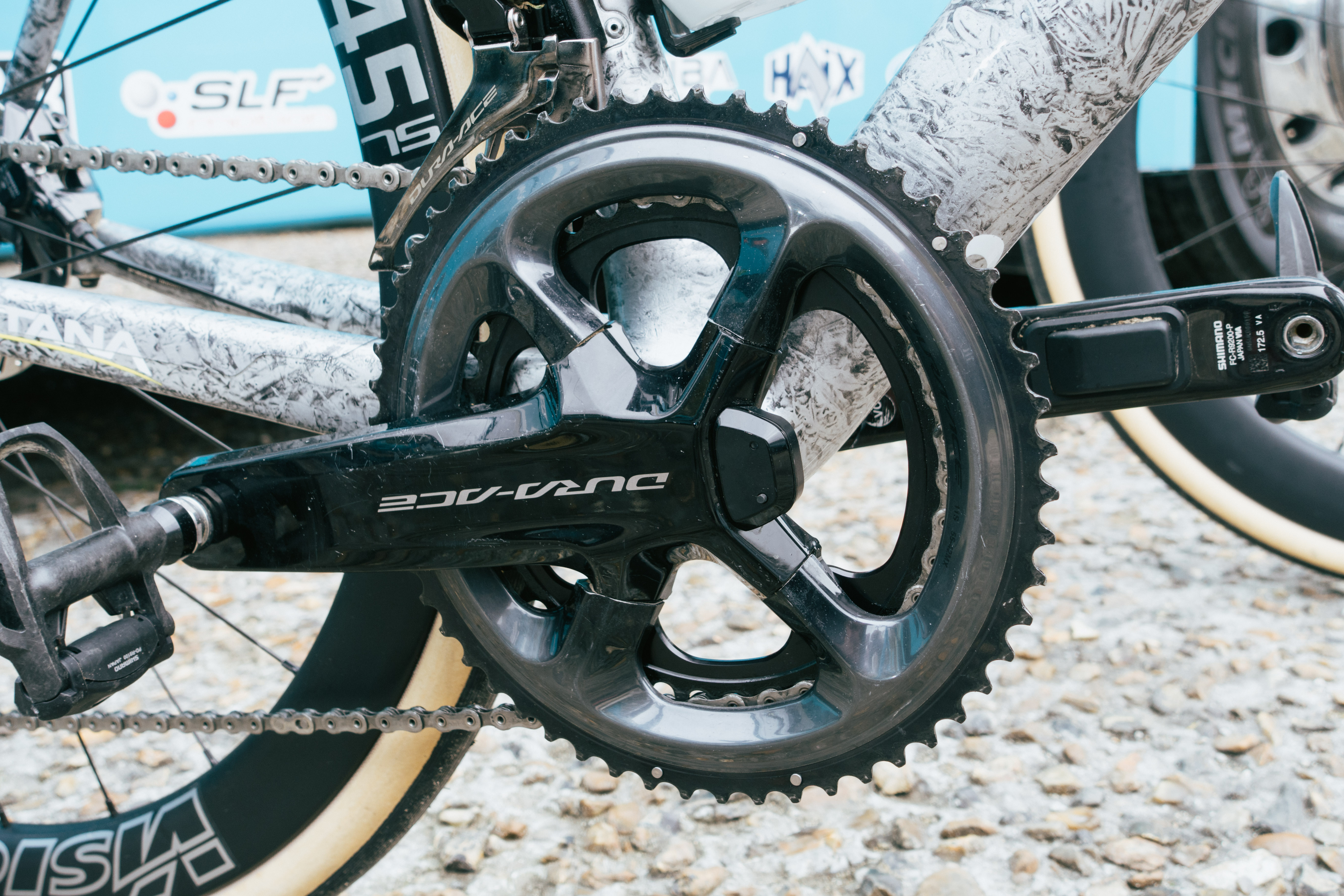
At Astana I was told the team has struggled to get chainrings from Shimano, hence this rider using old 11sp rings which apparently work just fine with the current 12sp system, though Shimano would likely say otherwise.
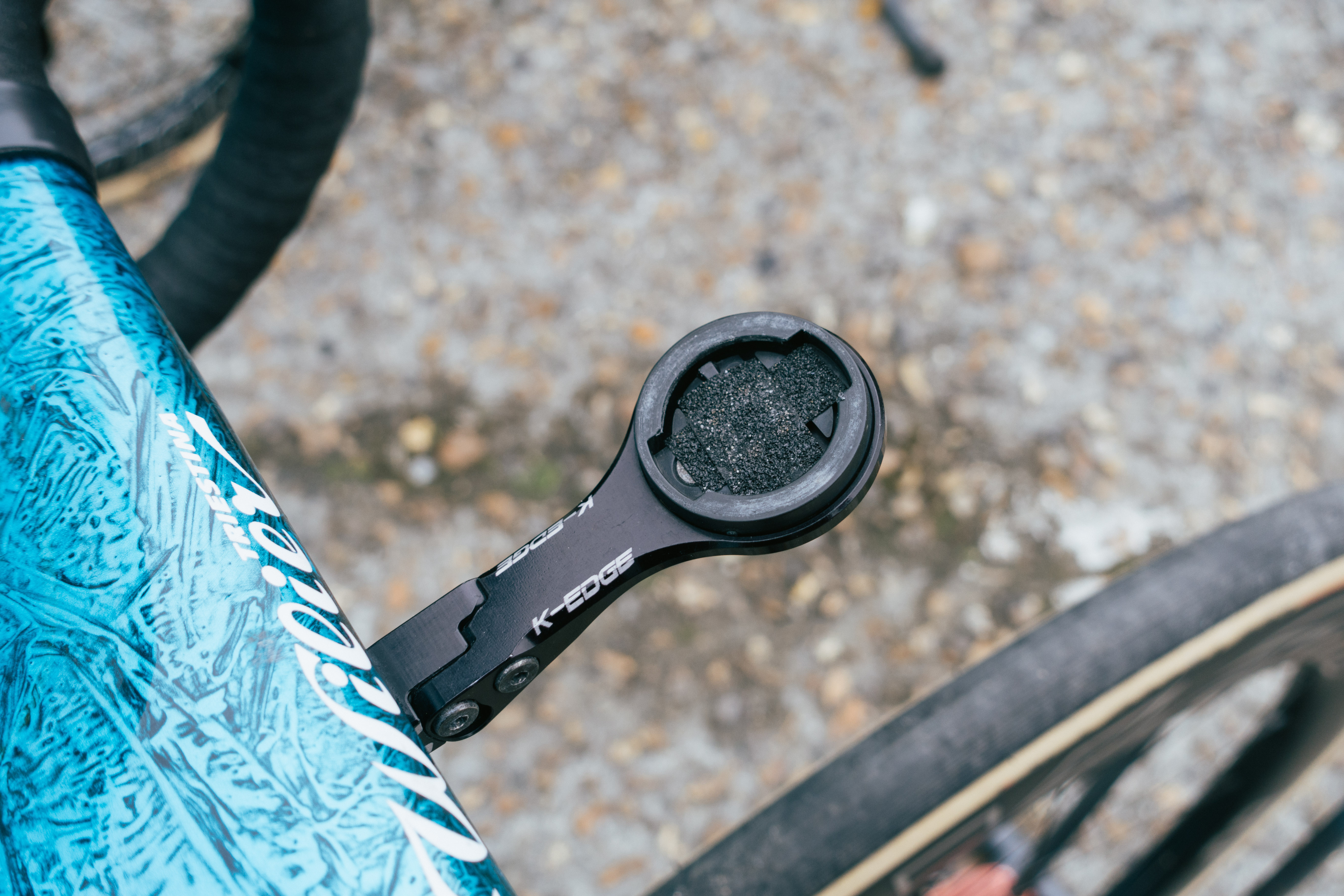
As ever, a little bit of sticky backed Velcro does wonders to stop any rattling, or worse a full ejection.
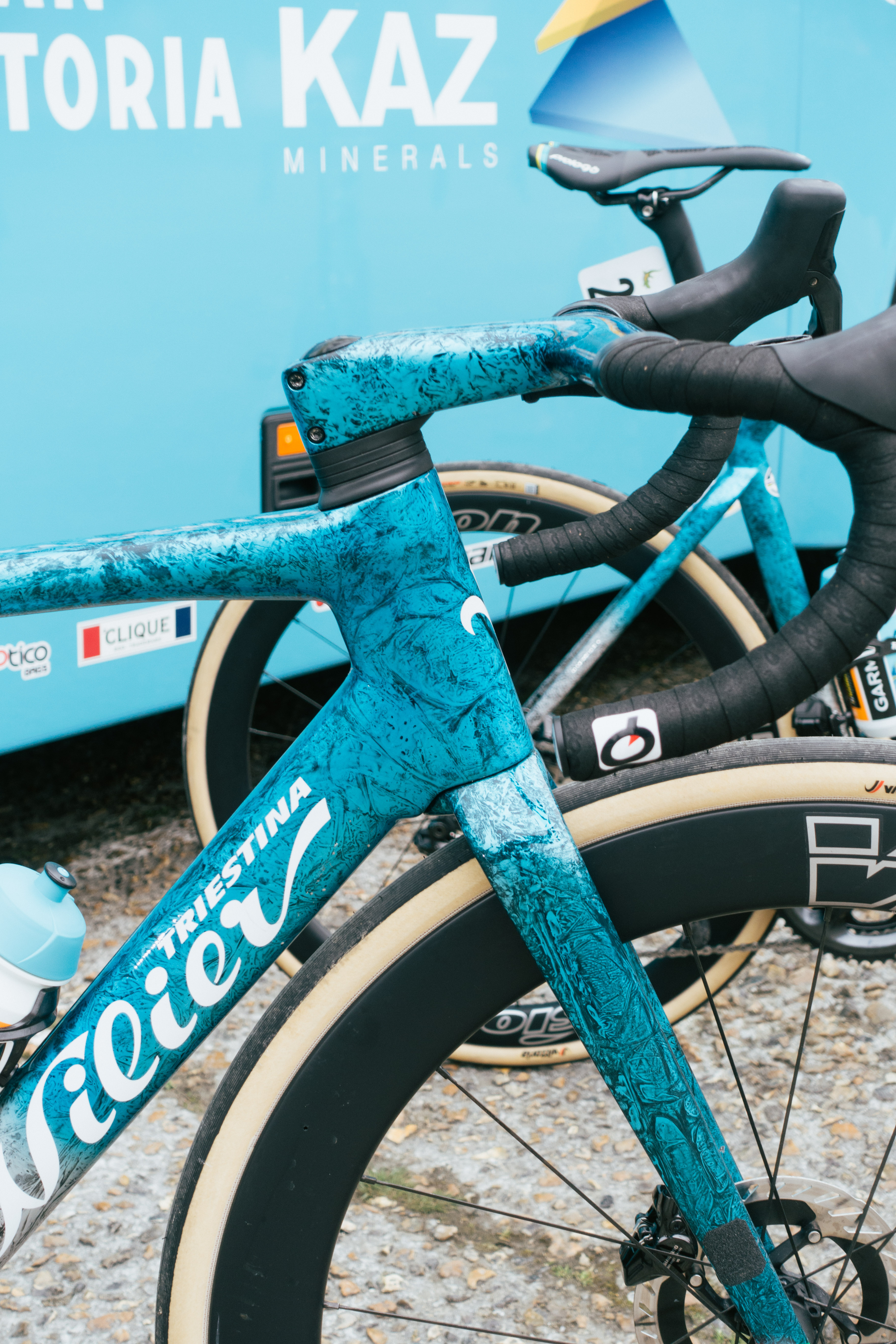
Chainring issues aside, the paint on these Wilier bikes is marvellous. The team were all on the custom painted bars, perhaps because it would be a shame not to, or perhaps for budget reasons.
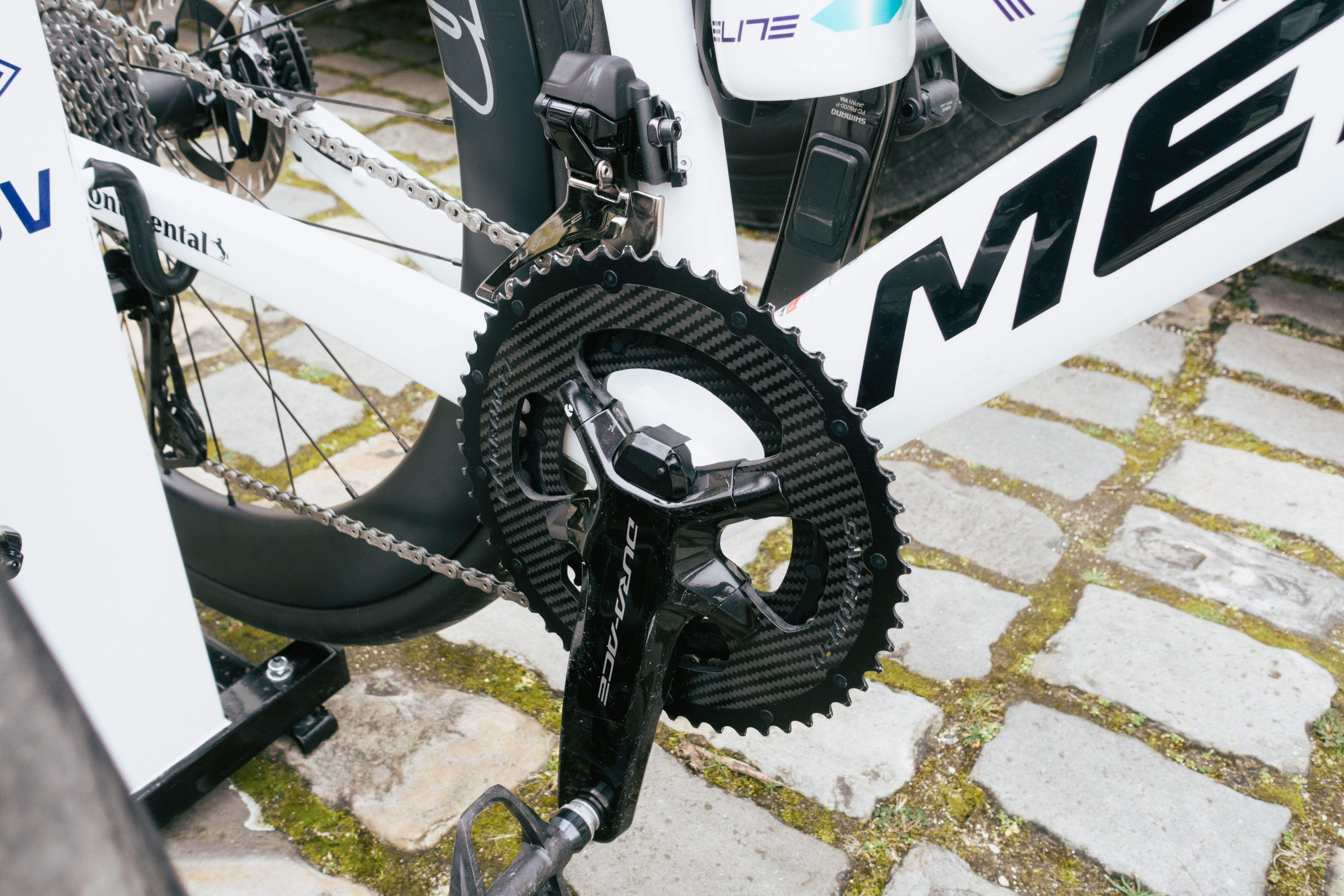
At Bahrain Victorious Fred Wright was using the Carbon Ti chainrings I've normally come to associate with UAE Team Emirates.
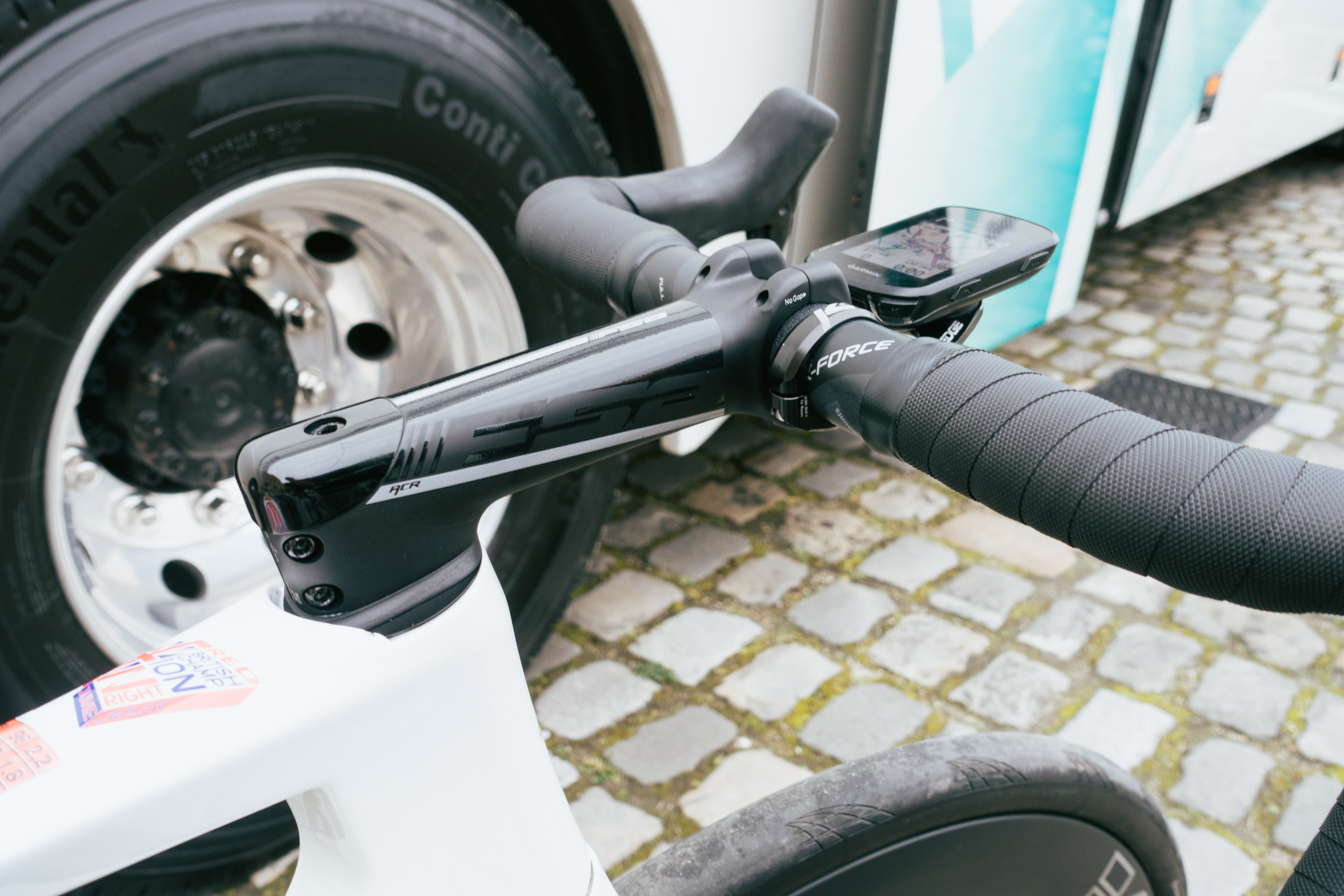
The usual white Vision Metron cockpit of his British champion's bike has been swapped for a separate system so he can use round bars.
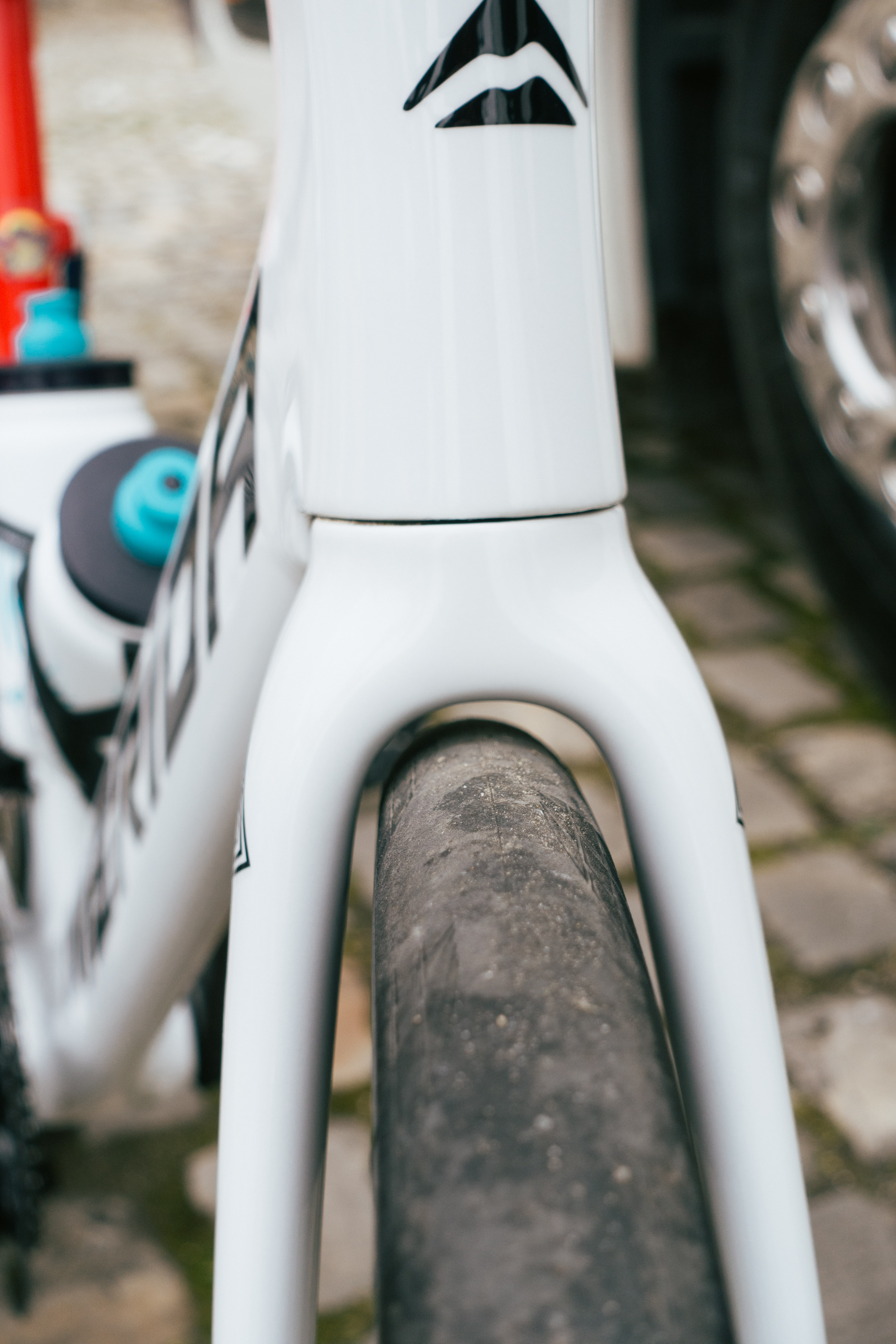
These tyres, 35c Continental GP5000 AS TR ones, were the biggest of the day, with barely any more room in the fork.
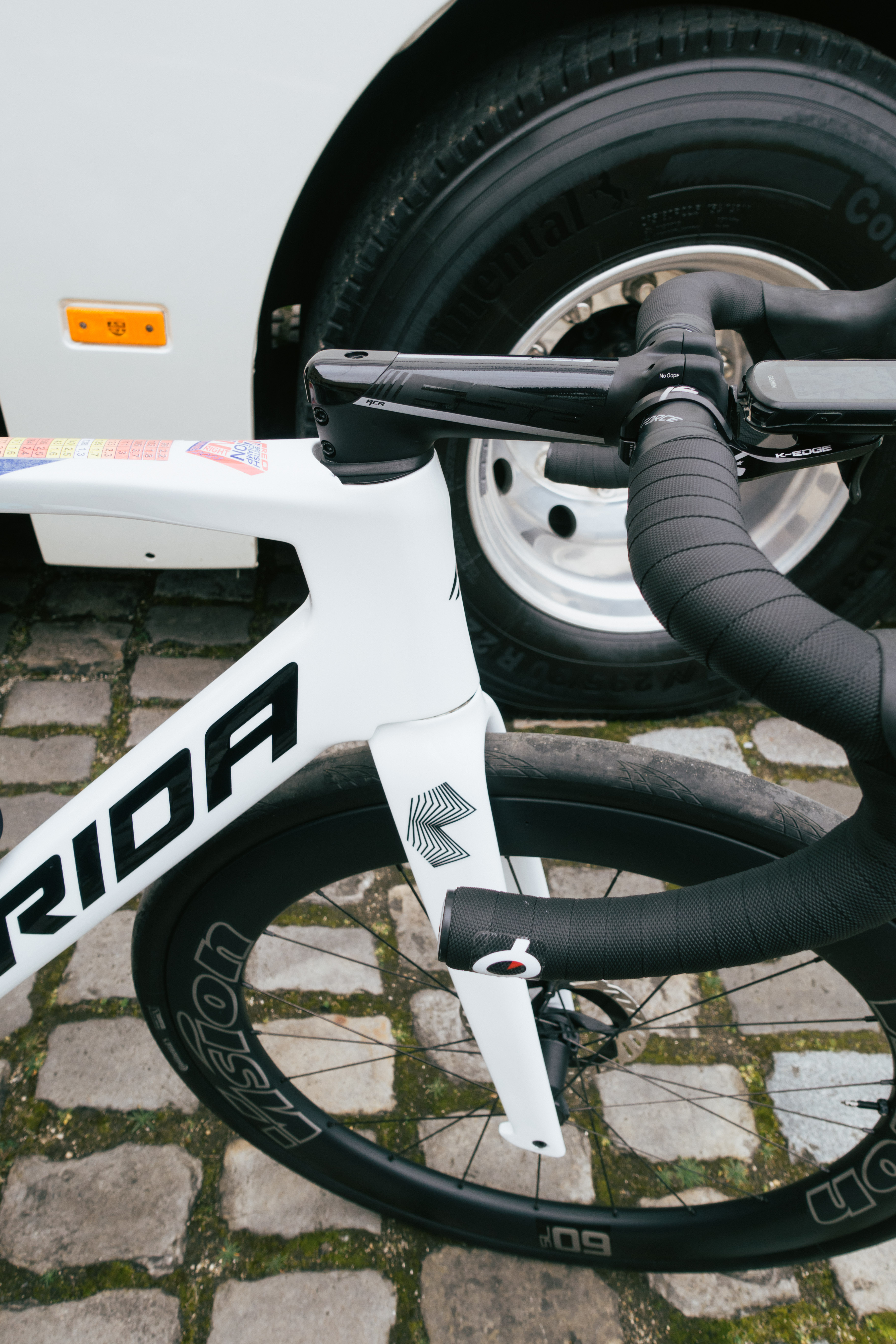
It's not as long as Rutsch's stem, but it's still a bigun. He's not using Prologo's new bar tape though, despite it being a team sponsor.
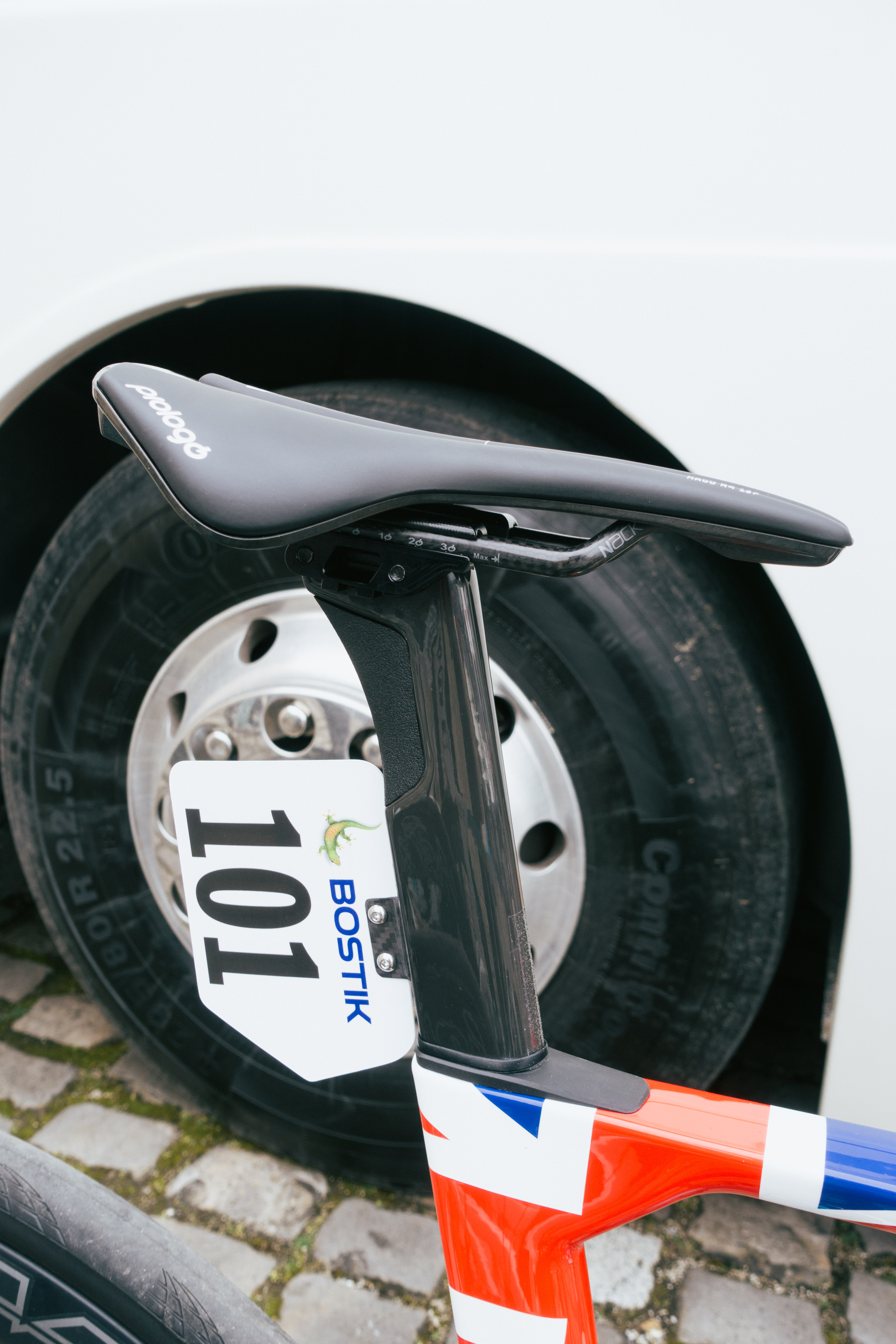
Much like the Scott Foil, this Merida has a seatpost with a shock absorbing dampener in it, but we have seen Wright use this before, rather than it being a new mod just for Roubaix.
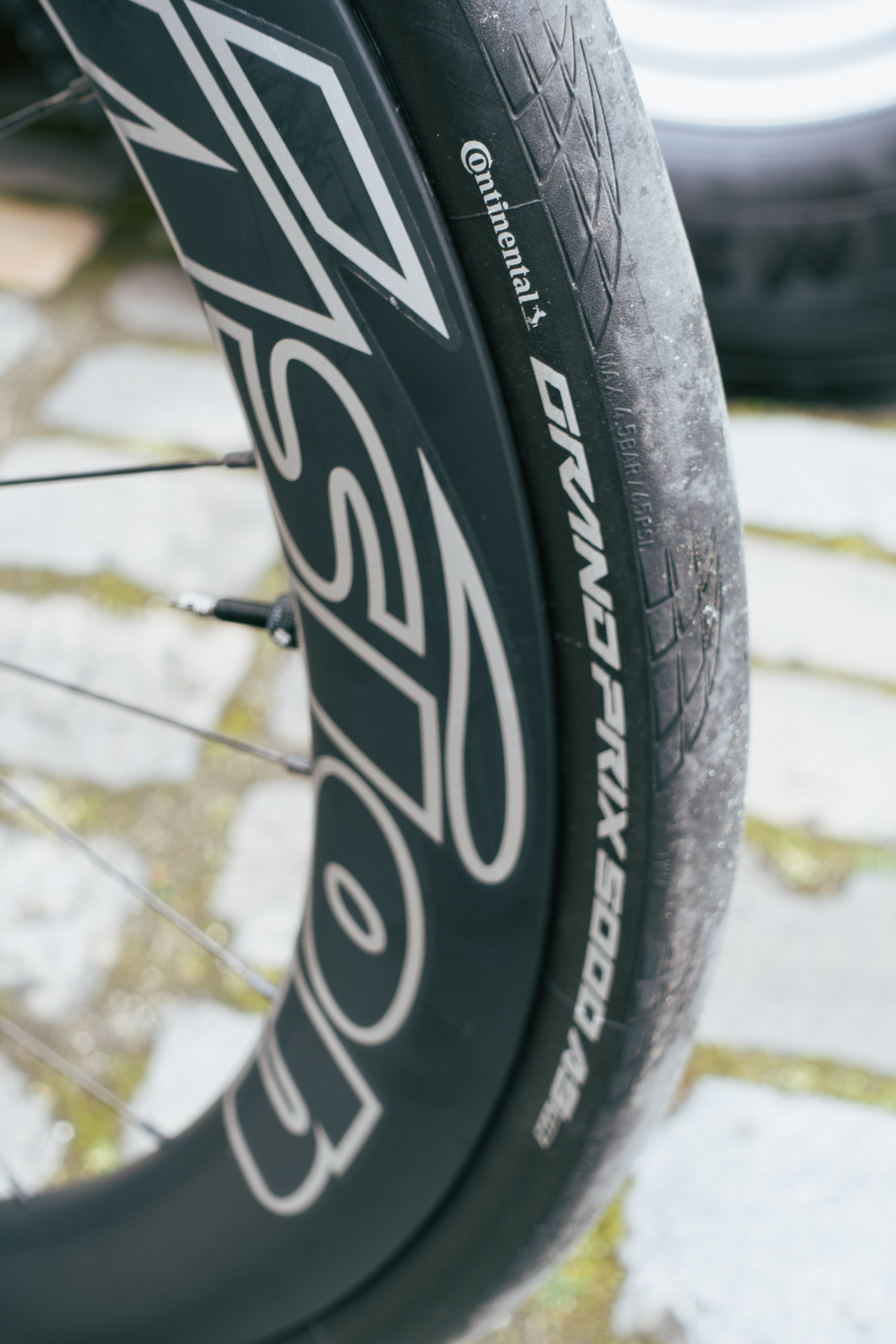
The all season (AS) version of the GP5000 offers more grip, better puncture protection, and importantly comes in a 35c width.
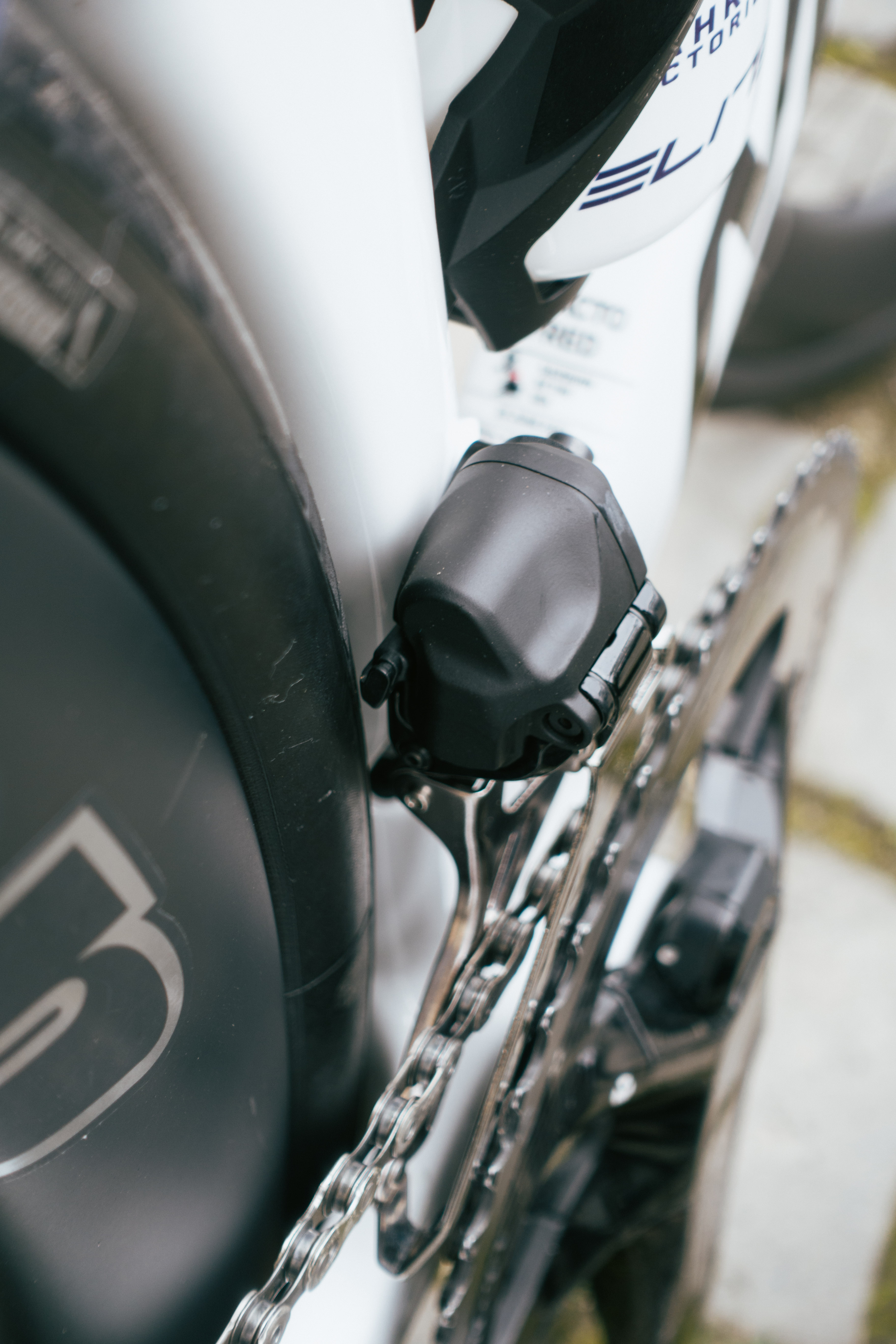
You could barely squeeze another millimeter more rubber in there before it fouls on the front derailleur.
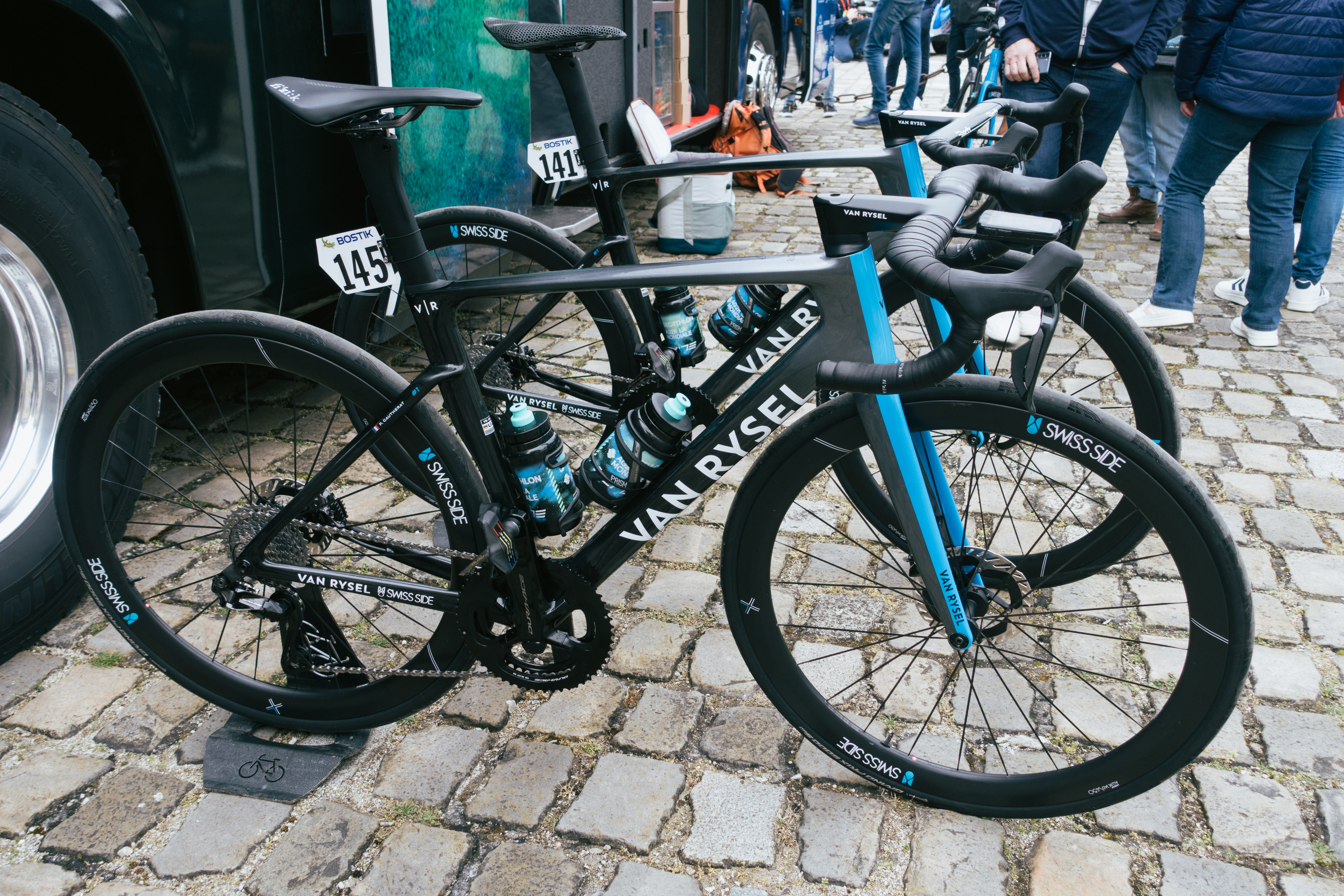
The Van Rysel RCR Pros of Decathlon-AG2R were mostly stock, save for some aftermarket chainrings and bigger tyres.
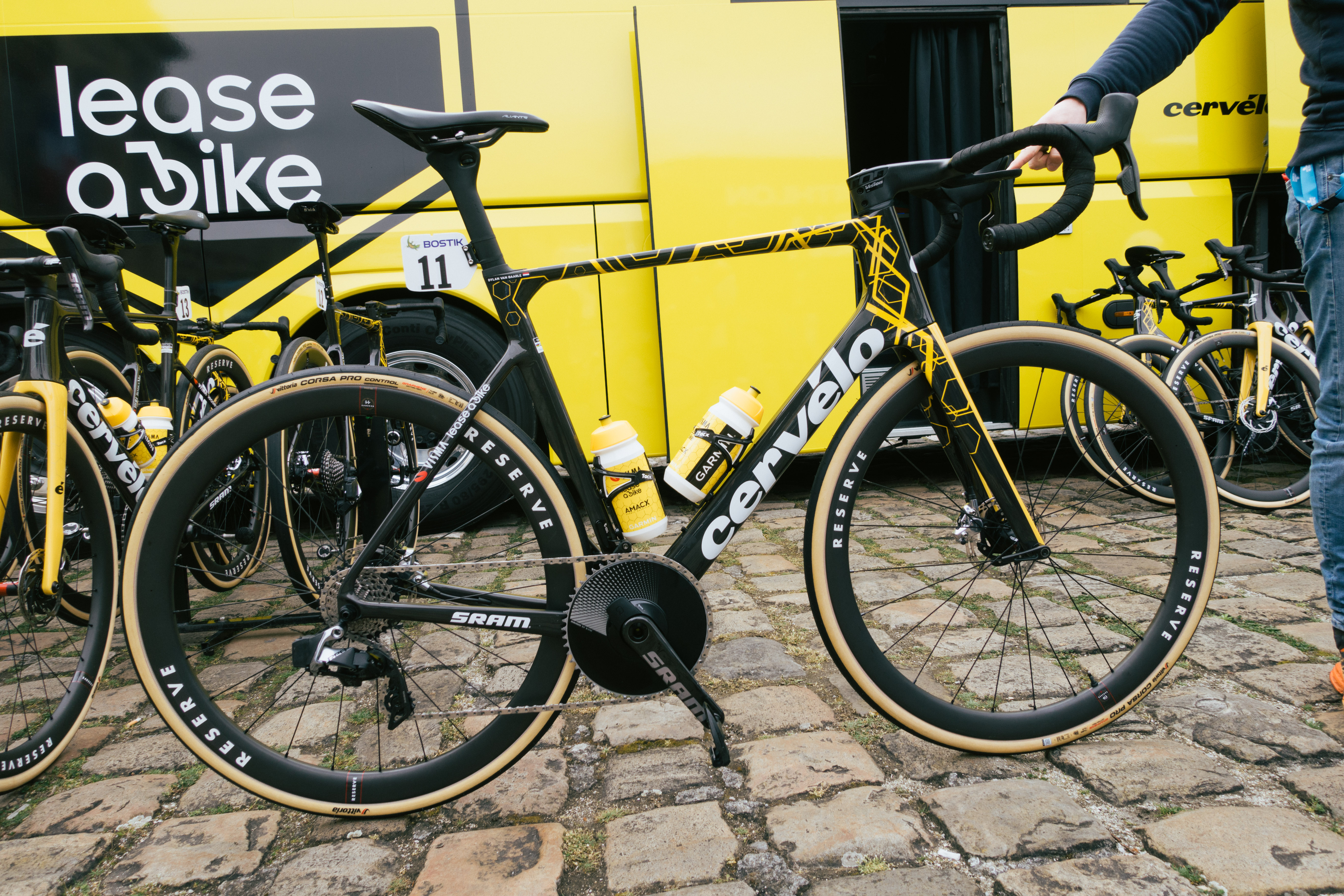
Former winner Dylan van Baarle was aboard the Cervelo Soloist today, with 32c tyres and (you guessed it) a 1x setup, though no enormous chainrings for the Dutchman. However, he didn't actually start the race.
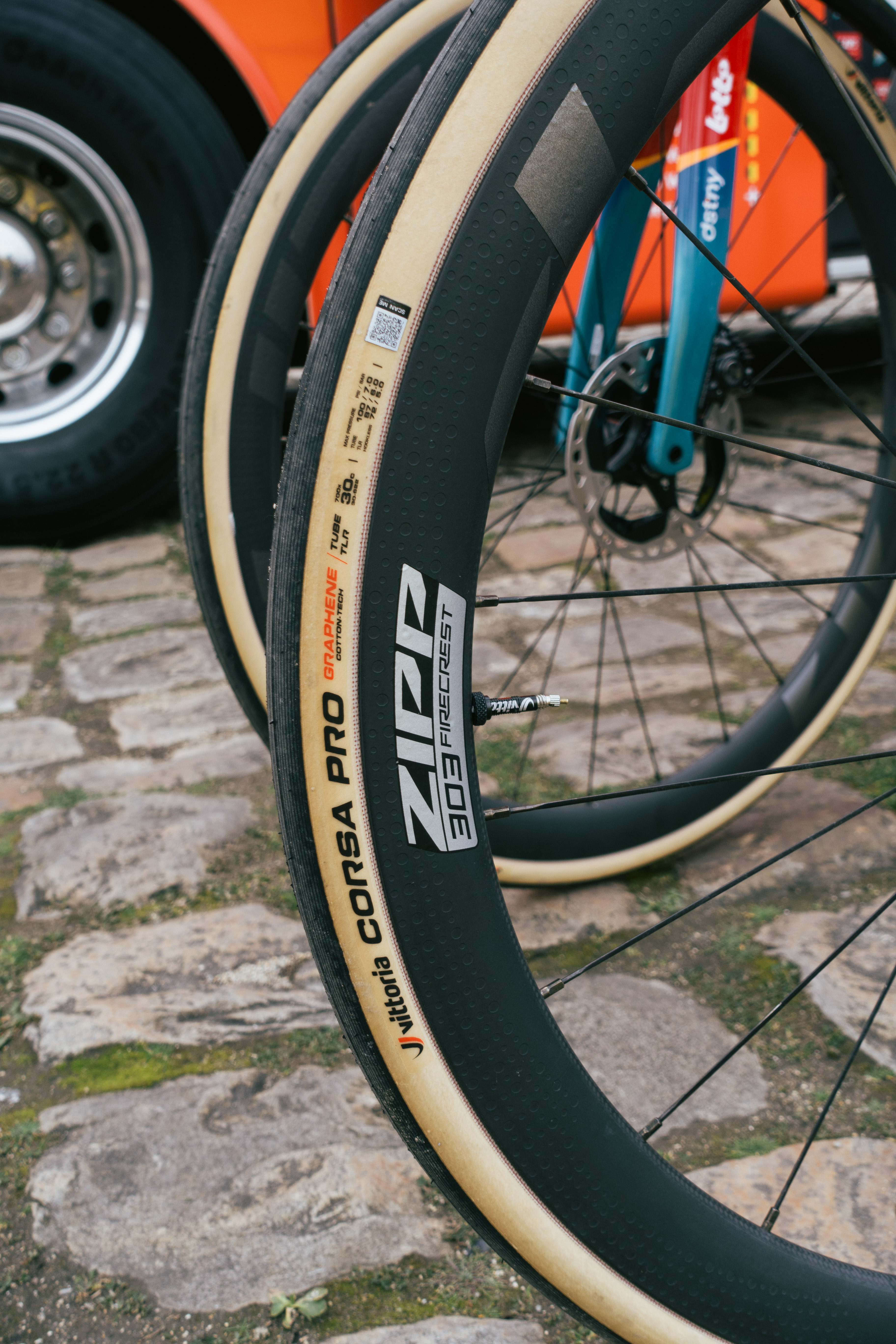
Despite all the talk of hookless rim failures, Lotto-DSTNY had some of the narrowest tyres at the race at 30c. They were tubeless with inserts, and the Zipp 303 Firecrest wheels are more akin to a gravel wheelset, but they are still hookless. The 30c tyre size is the upper limit of the Orbea Orca Aero team bikes, so maybe they wanted to go bigger but simply couldn't.
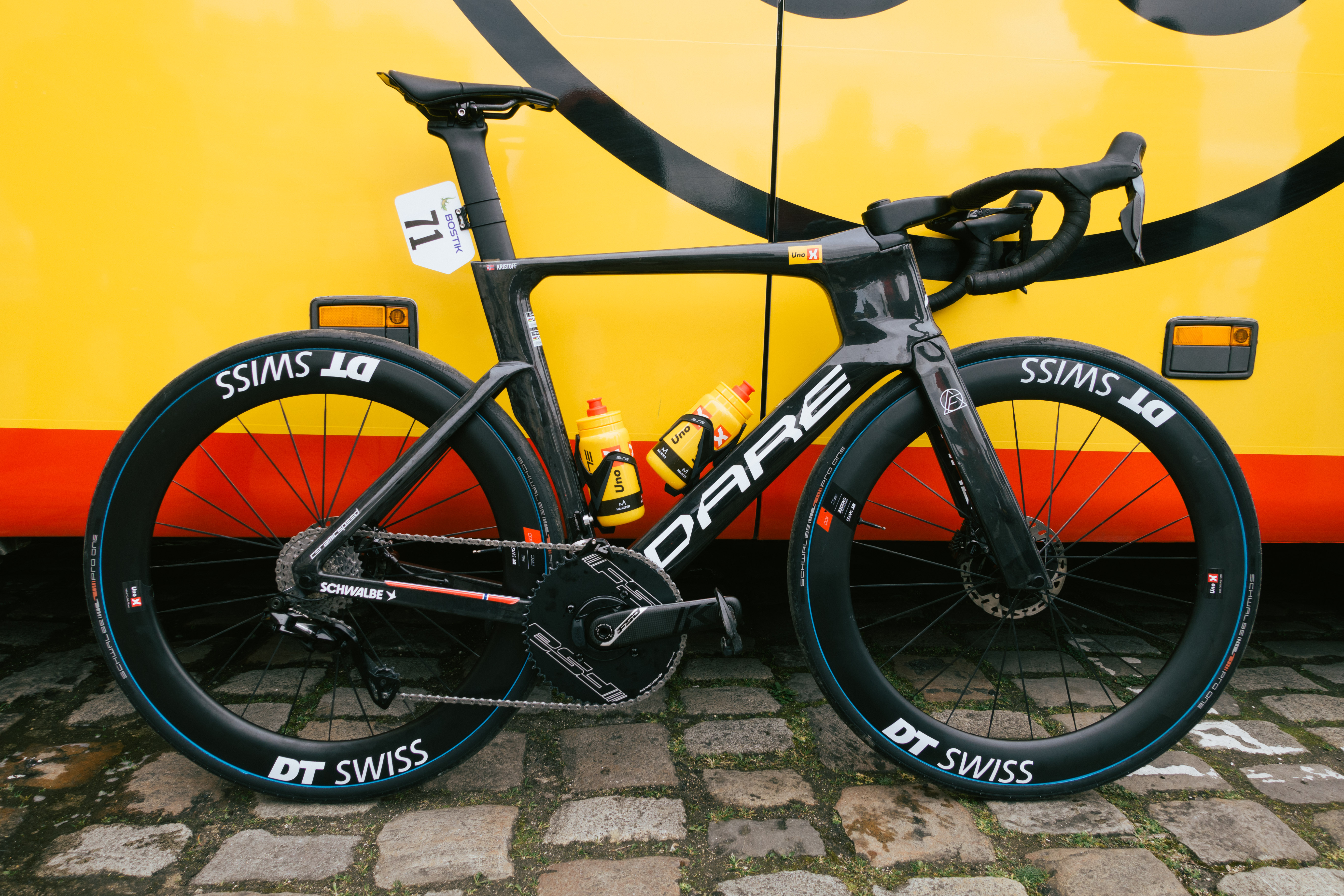
We've already covered this prototype Dare in a separate news piece, but it's still worthy of a second look. It has a simply enormous head tube, and normally would have an extremely chunky one piece cockpit, but one is not yet available in Alexander Kristoff's chosen 38cm width yet so he's using an old cockpit from the teams current bikes.
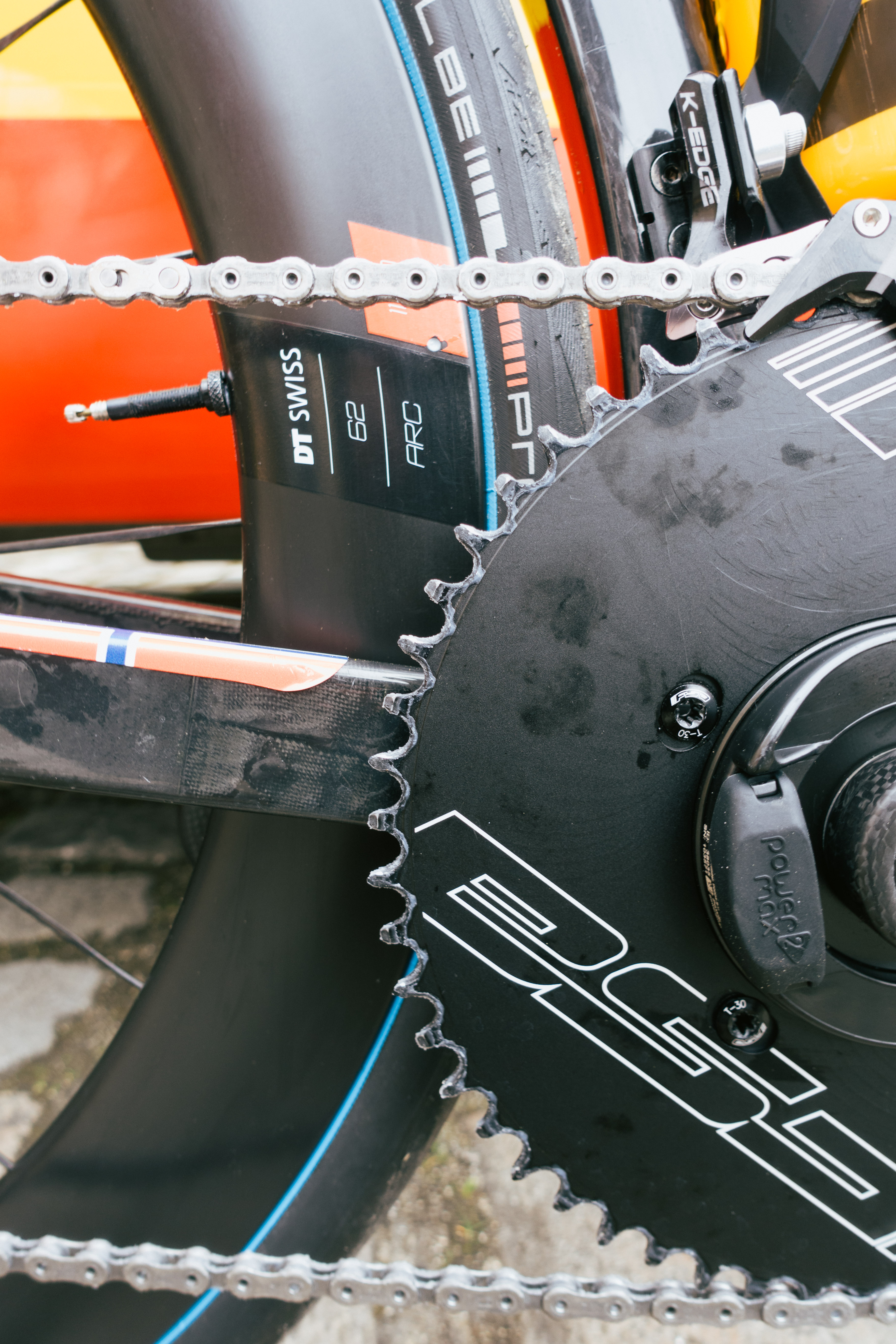
A 56t chainring, set up 1x, seems very fitting given Kristoffs reputation as a powerful rider, and the bike's aero credentials.
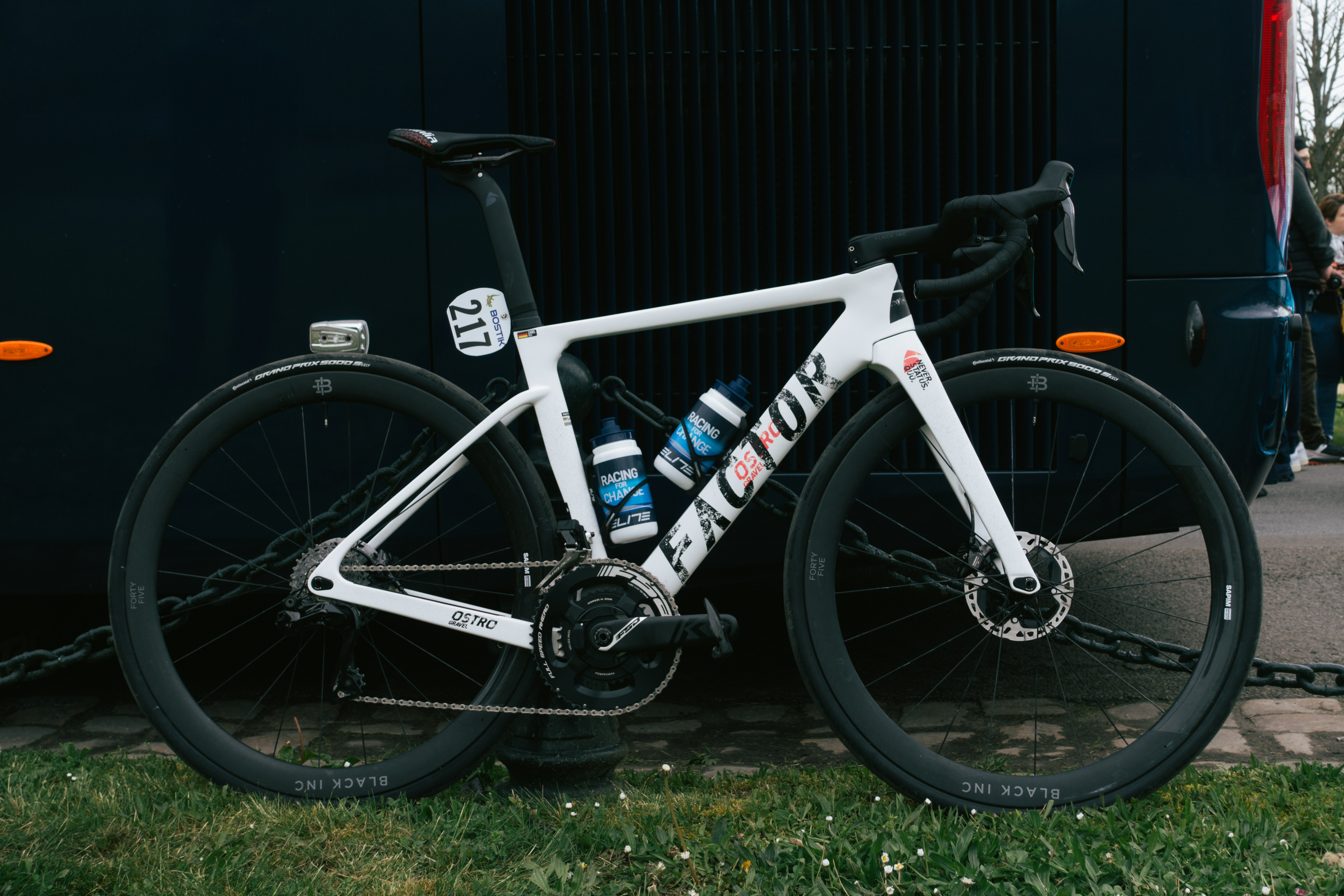
Move aside, road bikes, this is the first gravel bike to be raced at Paris Roubaix. Israel-Premier Tech rocked up on Factor Ostro Gravel bikes to the recon, and rode them in the race.
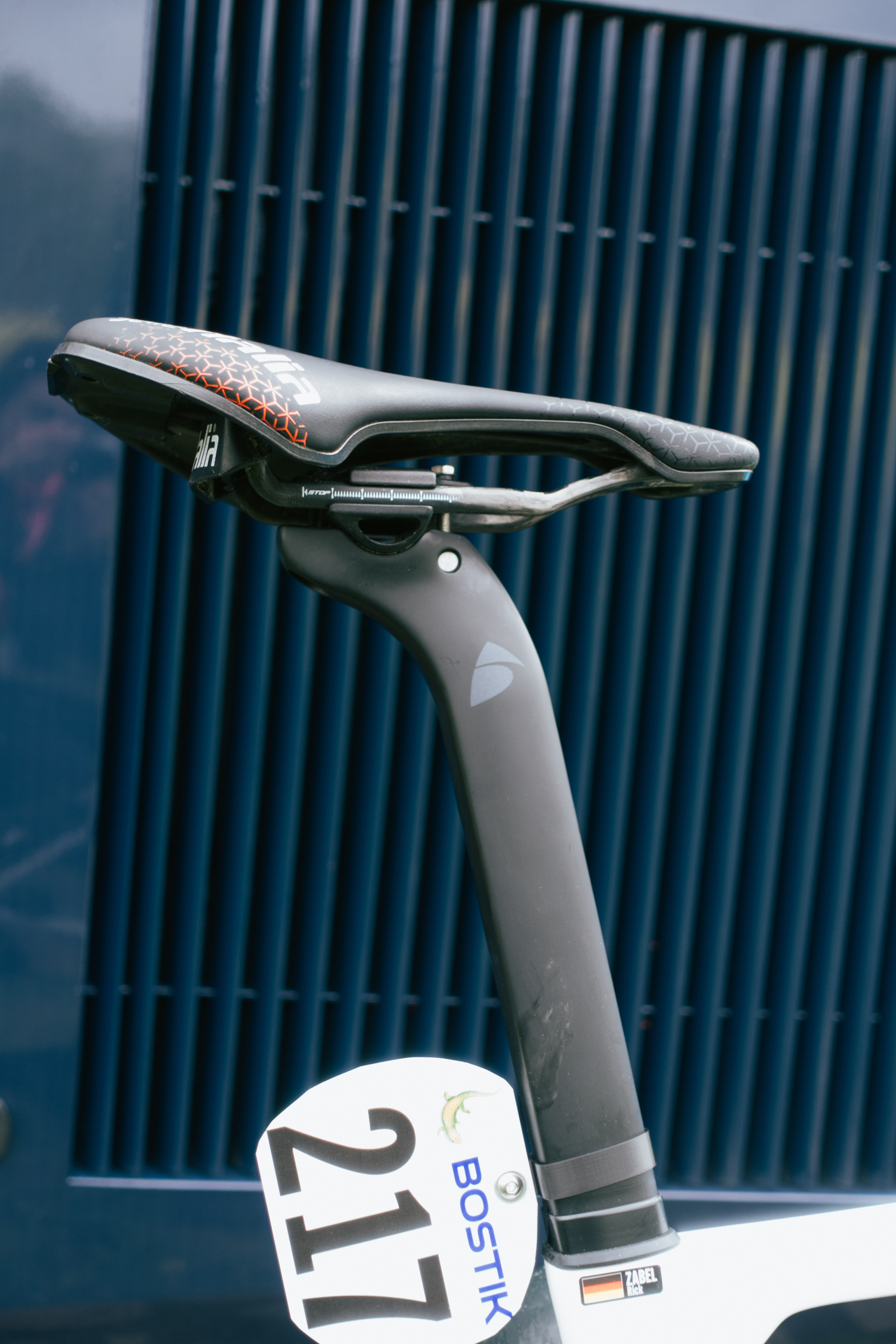
Some position changes were needed to offset the bikes shorter reach - setback seatposts and longer stems more or less did the trick I was told.
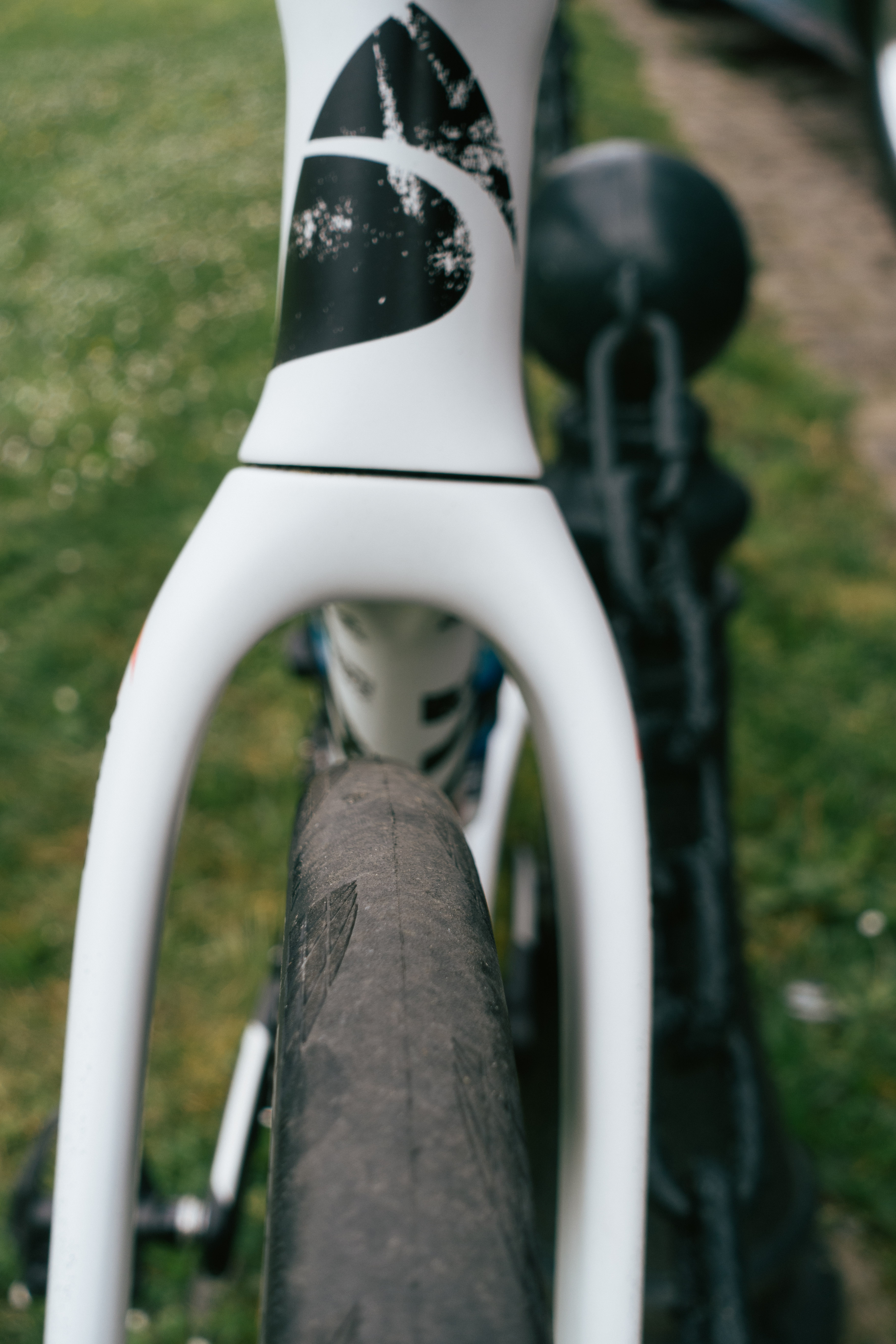
Sure, you can fit 45c tyres in should you wish, but that might have been overkill and perhaps a little draggy.
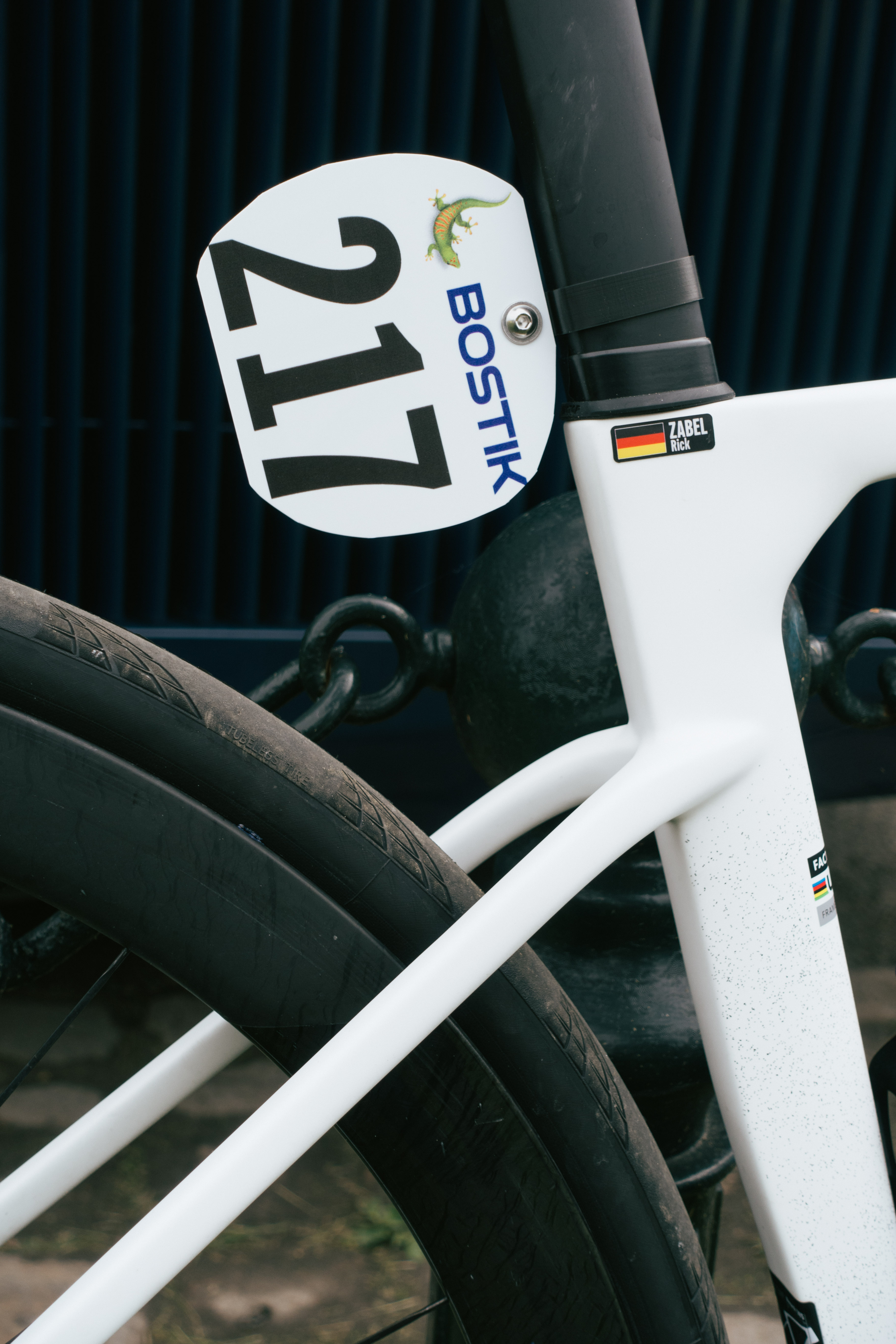
At the back there is clearance for a lot of mud too, and the bike has a slightly longer wheelbase.
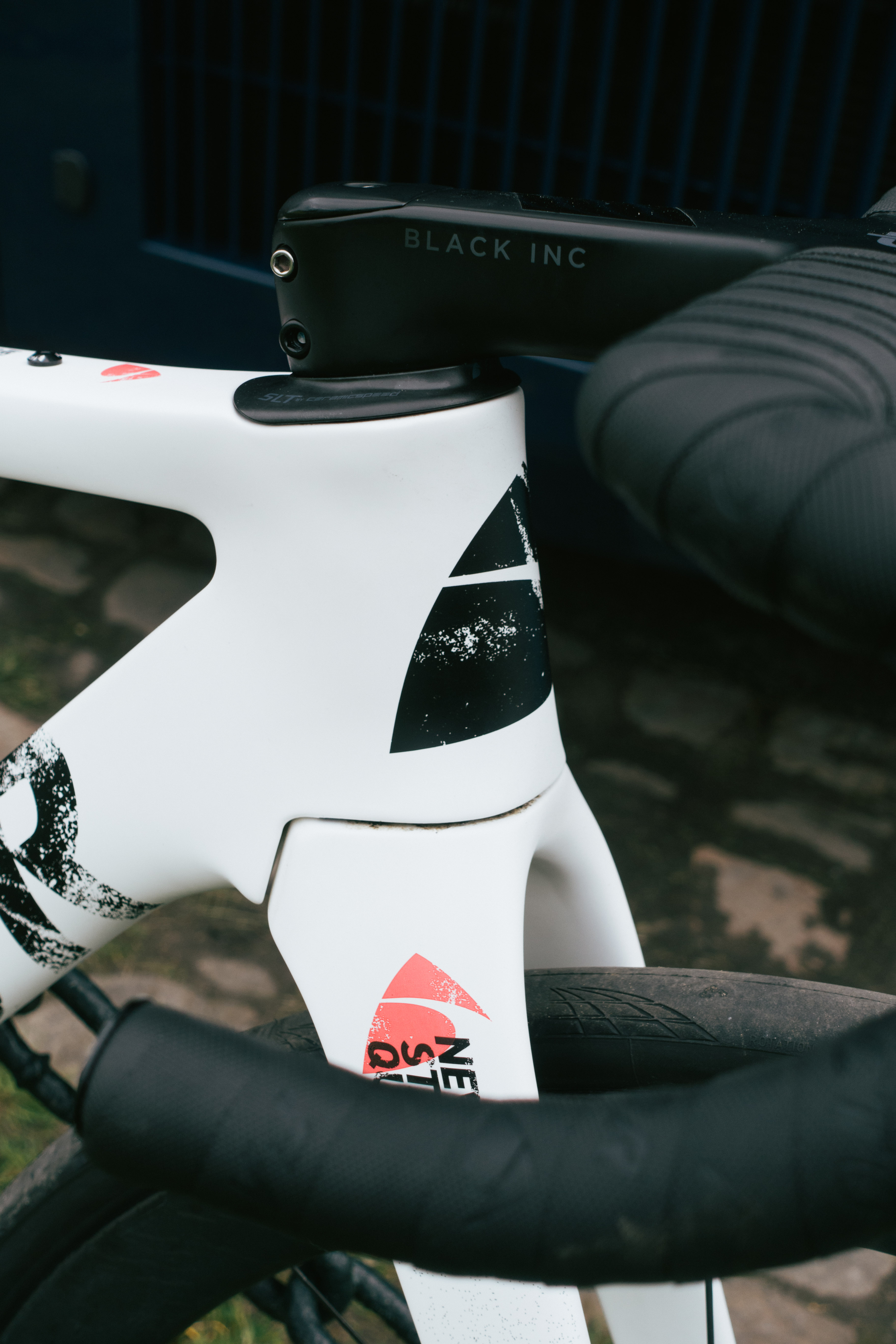
The Factor Ostro Gravel at the time of launch was the most aero gravel bike on the market, and to my knowledge nothing since has claimed to be faster. The super deep head tube and fork crown that sculpts into the main frame are key, and it's still within the UCI rules for tube depths.
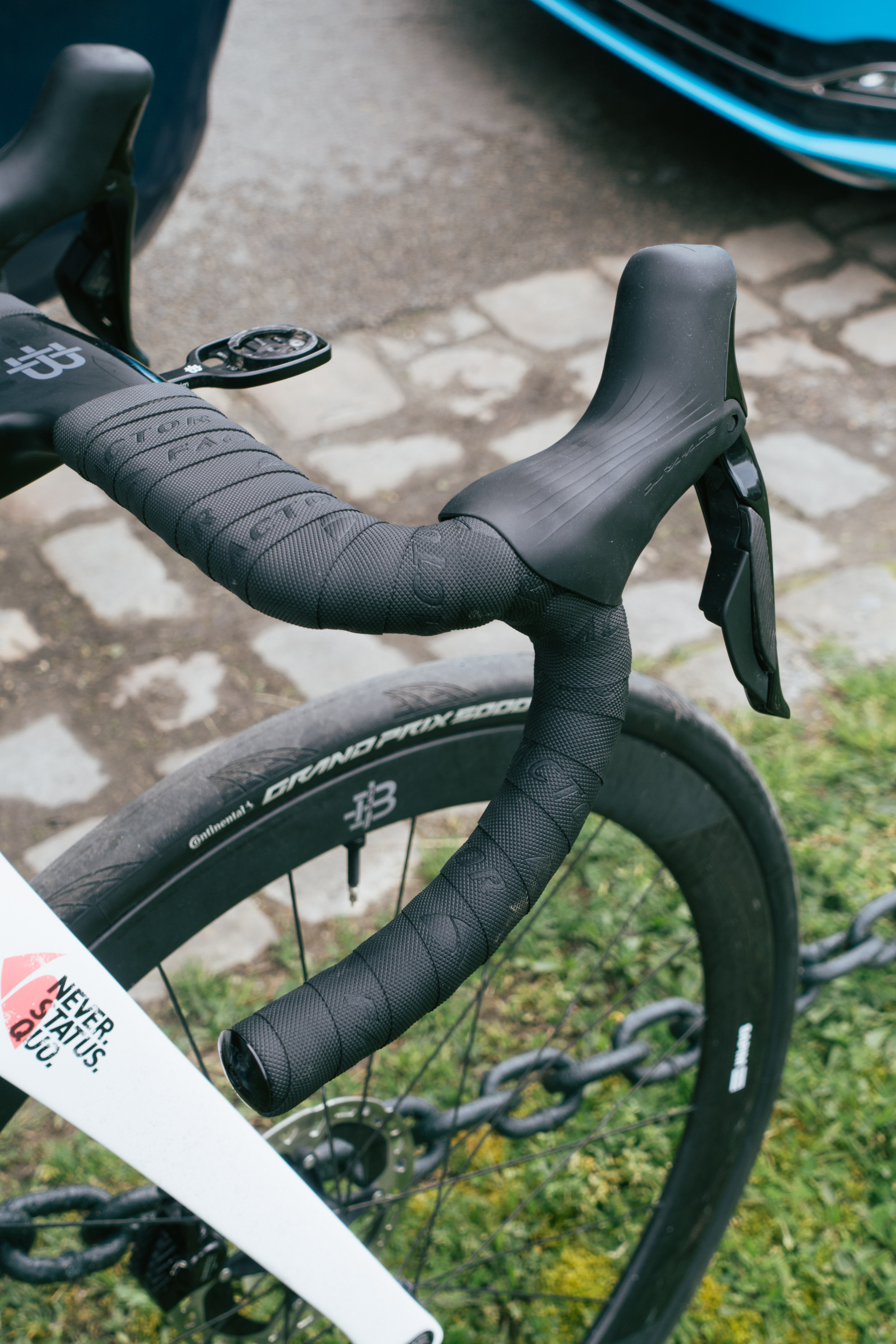
The bars were single wrapped, and the drops themselves have a good long section to hold when the going gets rough or fast.

The tyres were setup tubeless as you'd expect, and clearly some has leaked either during setup or during recon. I was told they'd perhaps like to go wider on the tyres, but the front derailleur gets in the way. Given how close the clearance was on the Merida of Fred Wright it might have fitted, but only just.
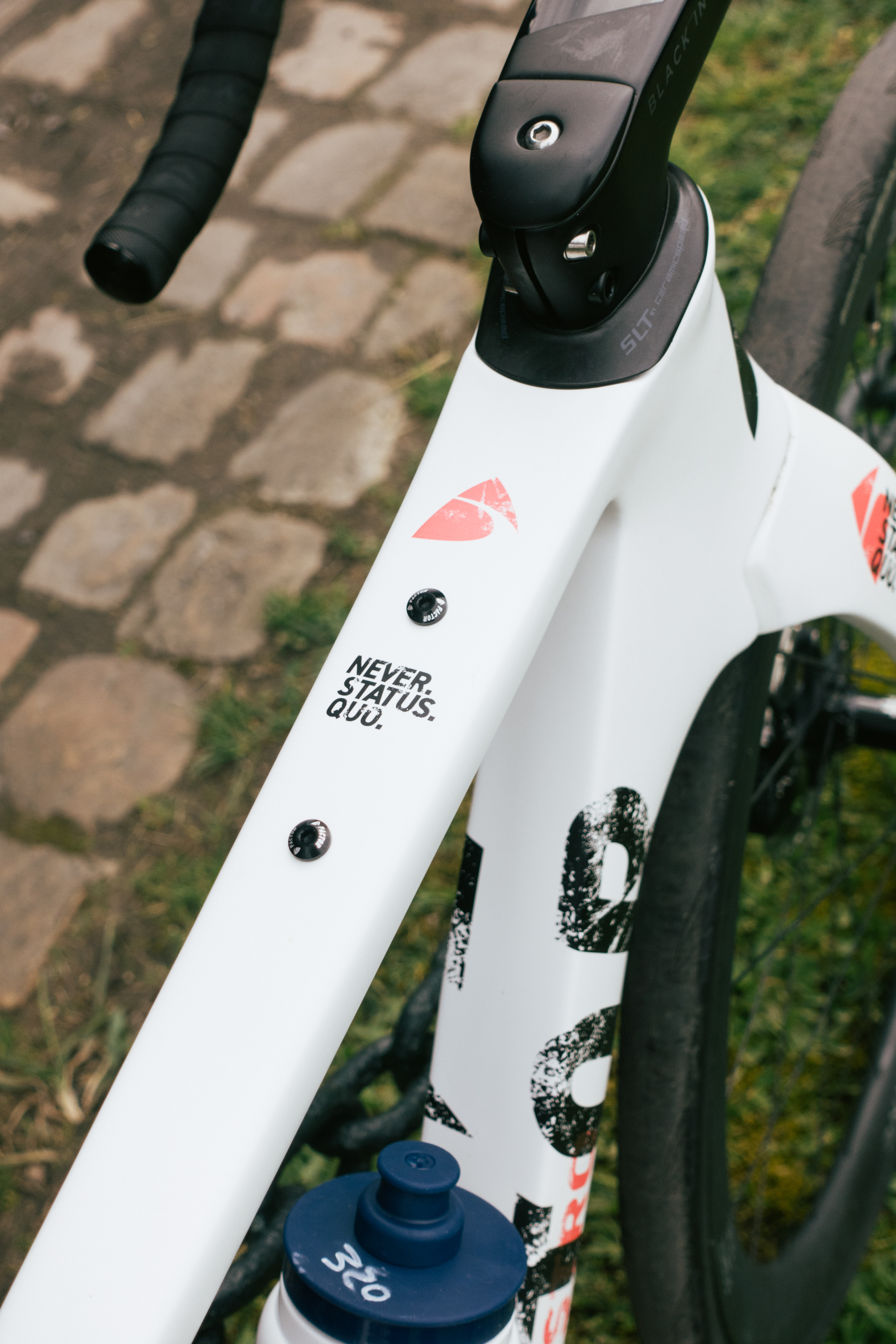
As well as being the first gravel bike at Roubaix, it's definitely the first bike to have bottle bosses on the top tube. Unsurprisingly none of the pros were running a top tube bag.
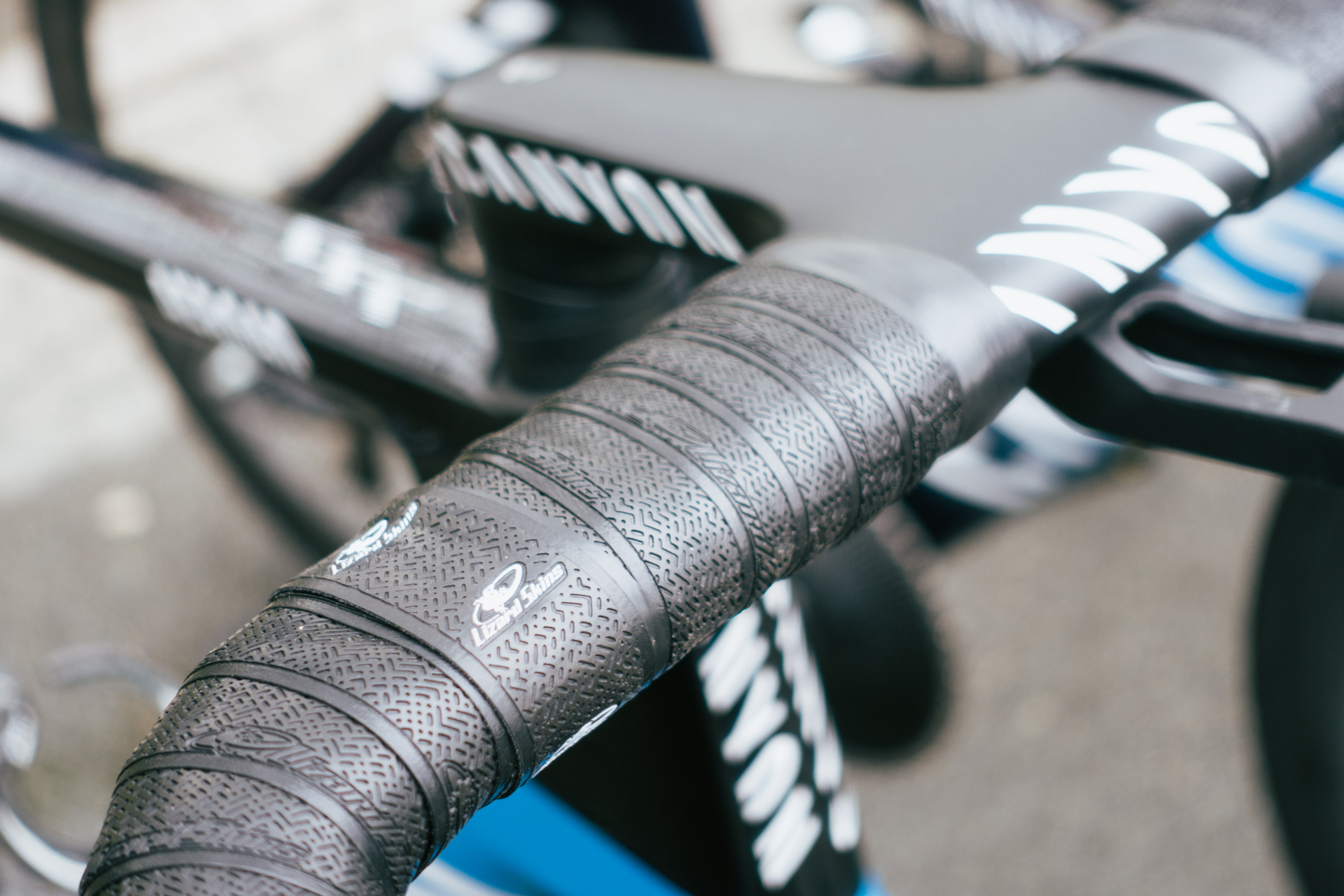
Finally, all the Movistar team bikes were double wrapped, but only on the tops. The Lizard Skins finishing tape is effectively just a strip of more bar tape, so the mechanics were able to make it a pretty seamless transition, though I can't help but feel a neater solution would be to wrap the second layer under the main one.
Is there anything we've missed? Let us know in the comments below, and stay tuned to Cyclingnews for all the race results, news and features from our team on the ground throughout the classics season.
Thank you for your Cyclingnews subscription. We use our subscription fees to be able to keep producing all our usual great content as well as more premium pieces like this one. Find out more here.
Get The Leadout Newsletter
The latest race content, interviews, features, reviews and expert buying guides, direct to your inbox!

Will joined the Cyclingnews team as a reviews writer in 2022, having previously written for Cyclist, BikeRadar and Advntr. He’s tried his hand at most cycling disciplines, from the standard mix of road, gravel, and mountain bike, to the more unusual like bike polo and tracklocross. He’s made his own bike frames, covered tech news from the biggest races on the planet, and published countless premium galleries thanks to his excellent photographic eye. Also, given he doesn’t ever ride indoors he’s become a real expert on foul-weather riding gear. His collection of bikes is a real smorgasbord, with everything from vintage-style steel tourers through to superlight flat bar hill climb machines.